Kanchanaburi
Following the small Khwae Noi River takes you from the city into the jungle. The tracks of the Death Railway cross your path again and again. A heavy downpour sweeps the streets clean. We climb uphill, deeper and deeper into the heart of the province, past waterfalls, lakes and historical sites. Kanchanaburi is a beautiful, almost enchanted province.
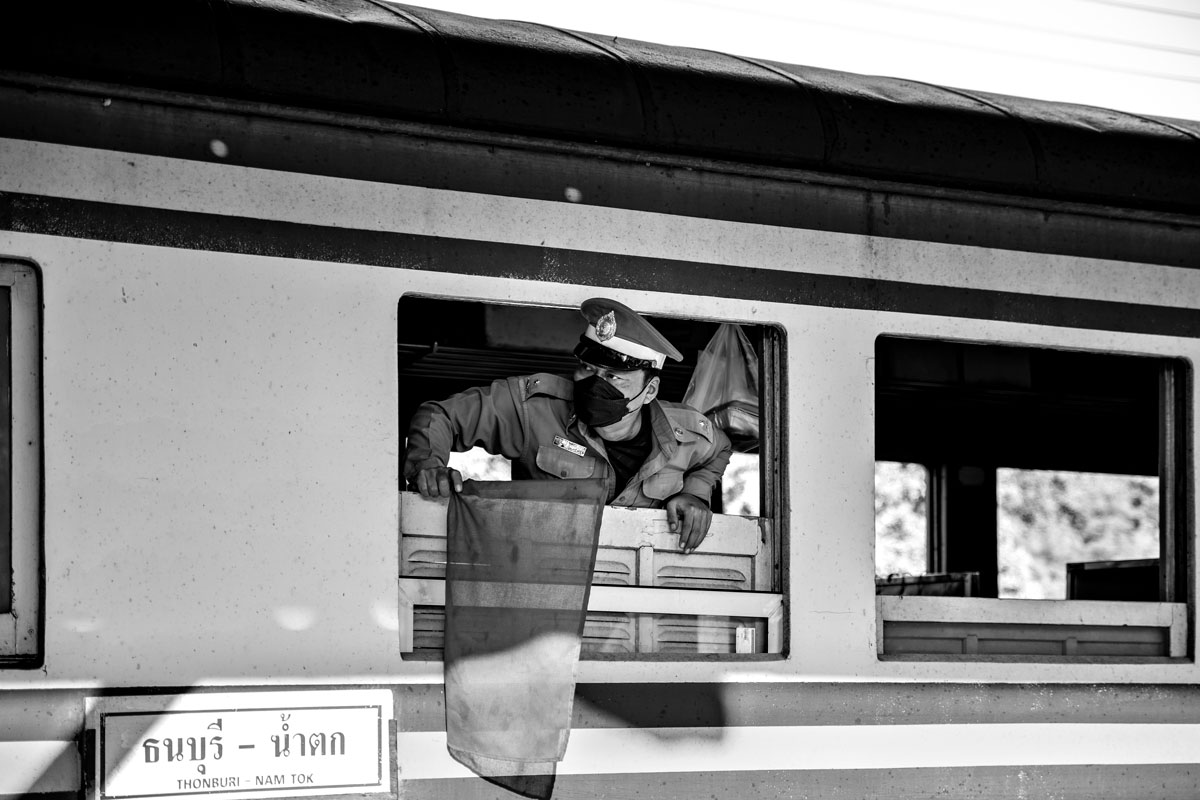
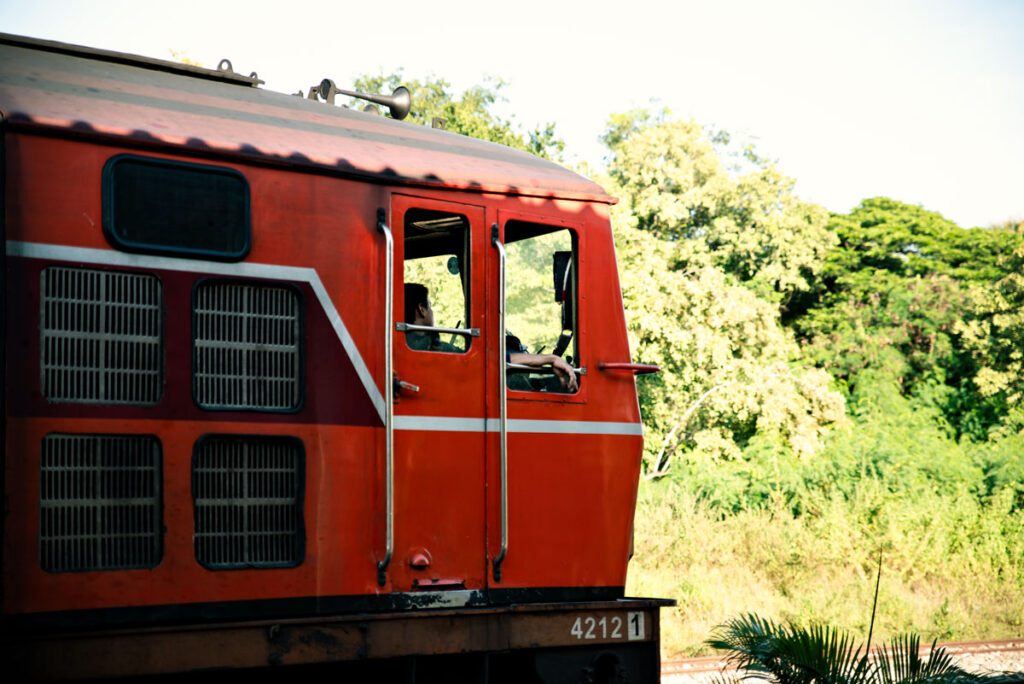
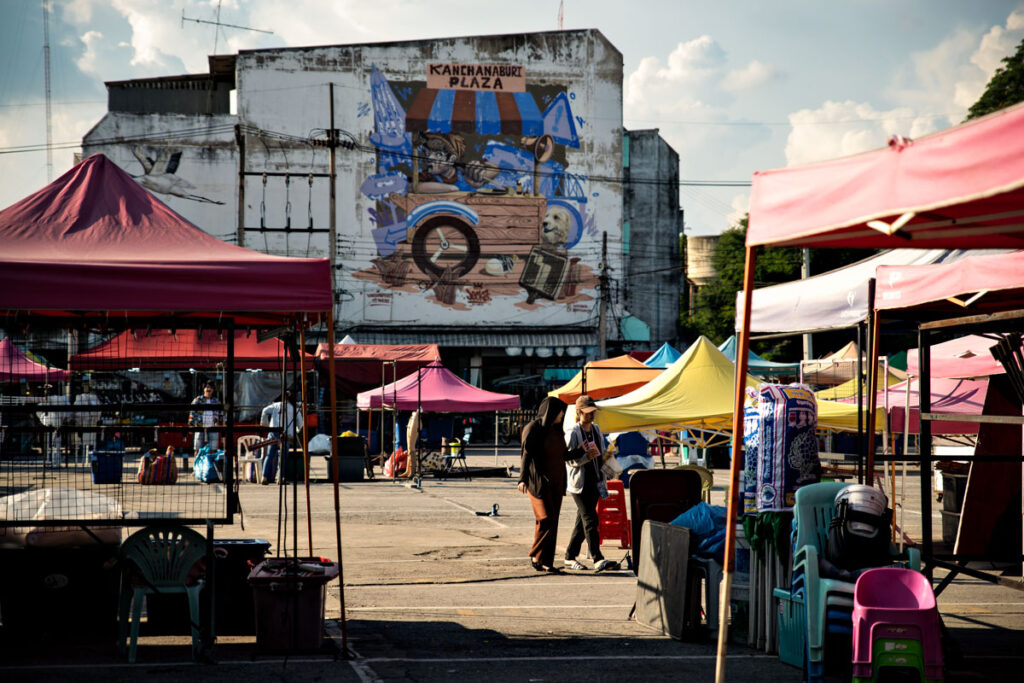
The ground shakes as the train rumbles into the station. It spits out tourists laden with large rucksacks, and just as many get back on board for the onward journey to the northwest. Flag waving, a loud whistle, then the monster rolls on. The train slowly disappears around the next bend. An old monk remains behind on a waiting bench. The market in front of the station is barely crowded on the hot afternoon.
A few meters further on, we enter the cemetery through a stone gate. The prisoners of war who died during the construction of the Burma Railway during the Second World War lie here in almost 7,000 graves – only a fraction of the victims of the Japanese death rage. A manic project – to create a link between Thailand and its neighbor Burma. Straight through hundreds of kilometers of malaria-infested jungle and unyielding granite.
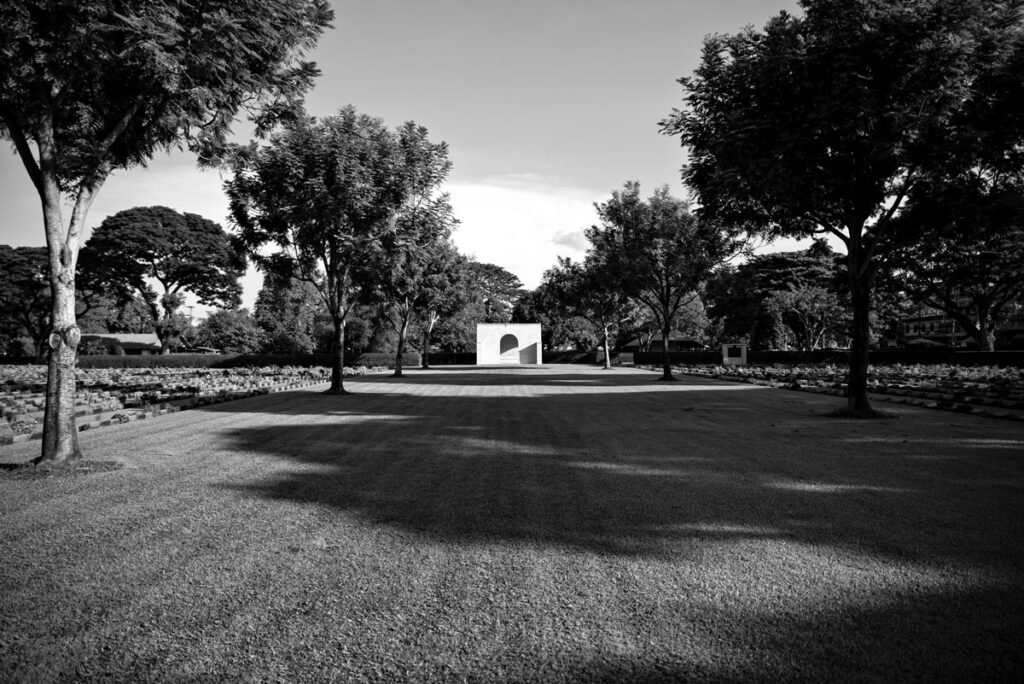
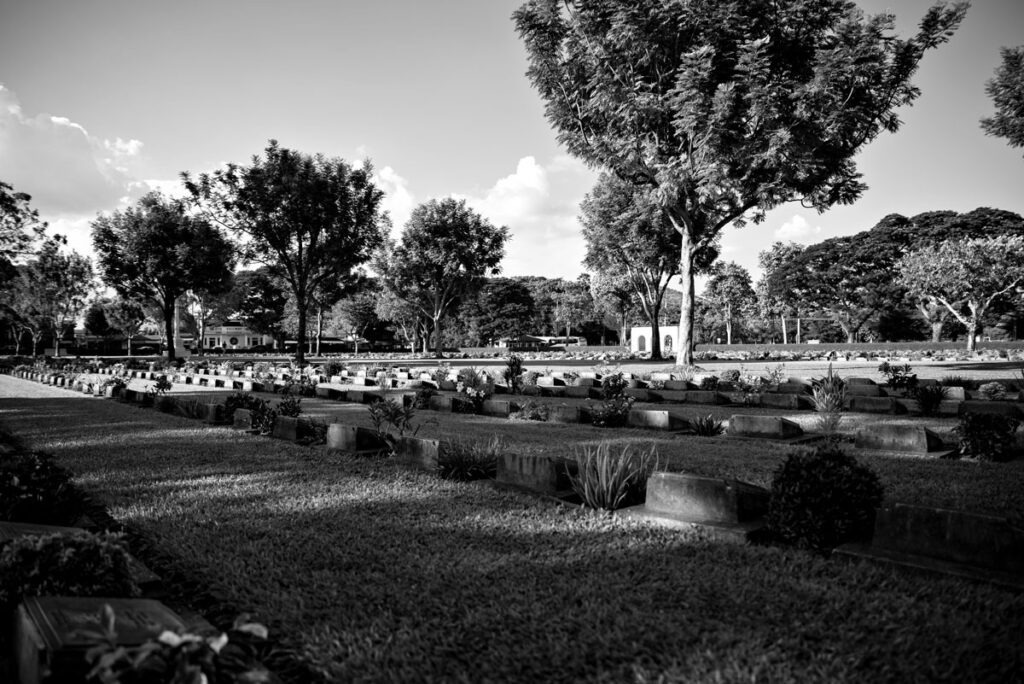
River Kwai Road is a street full of restaurants and hotels. This is where travelers who take the Death Railway get off. If you follow the road, you come to a crowded square. A steel bridge spans the river. Although it was almost completely rebuilt after the Second World War, it still stands for the horror of war and all its cruelties.
But horror and brutality quickly take a back seat to new ideas and new times. A Chinese temple rises up on the shore. Two boys earn a few baht by playing guitar songs. Restaurants on the waterfront serve seafood and backpackers pose in front of the bridge. Who can imagine heavy artillery, bomb explosions and starving prisoners in this place?
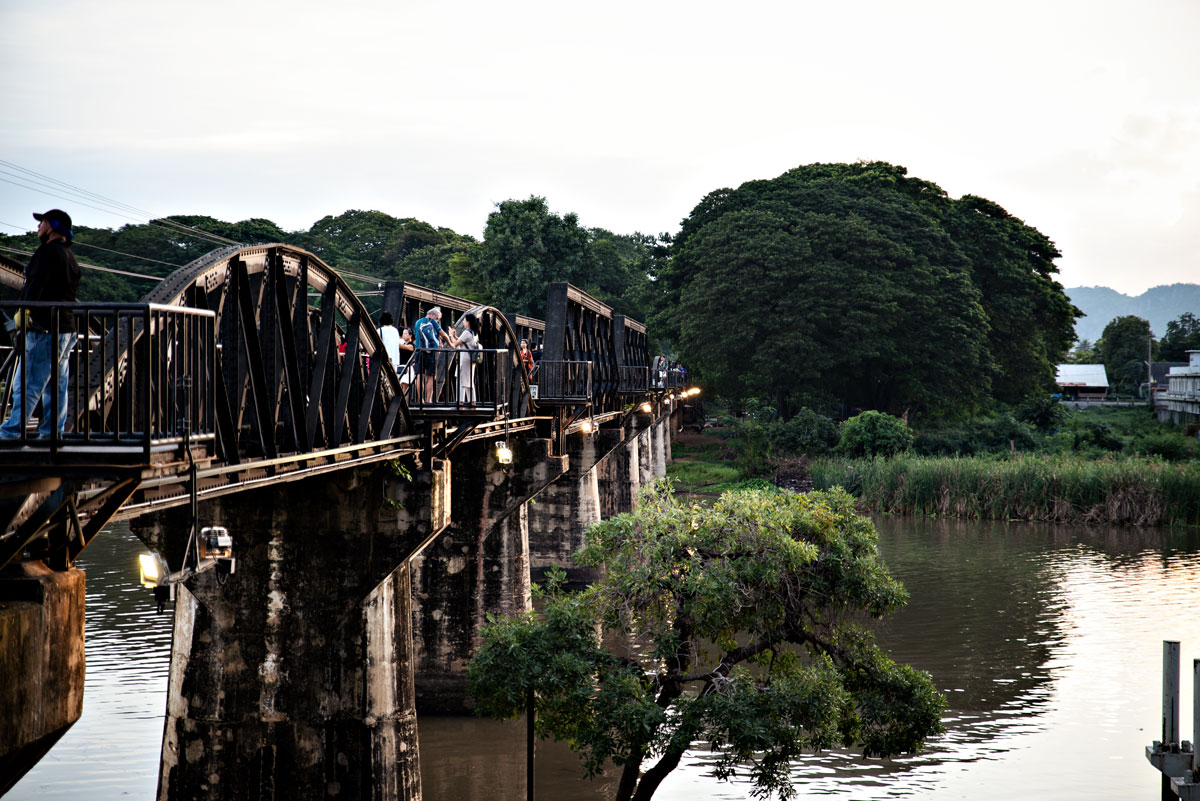
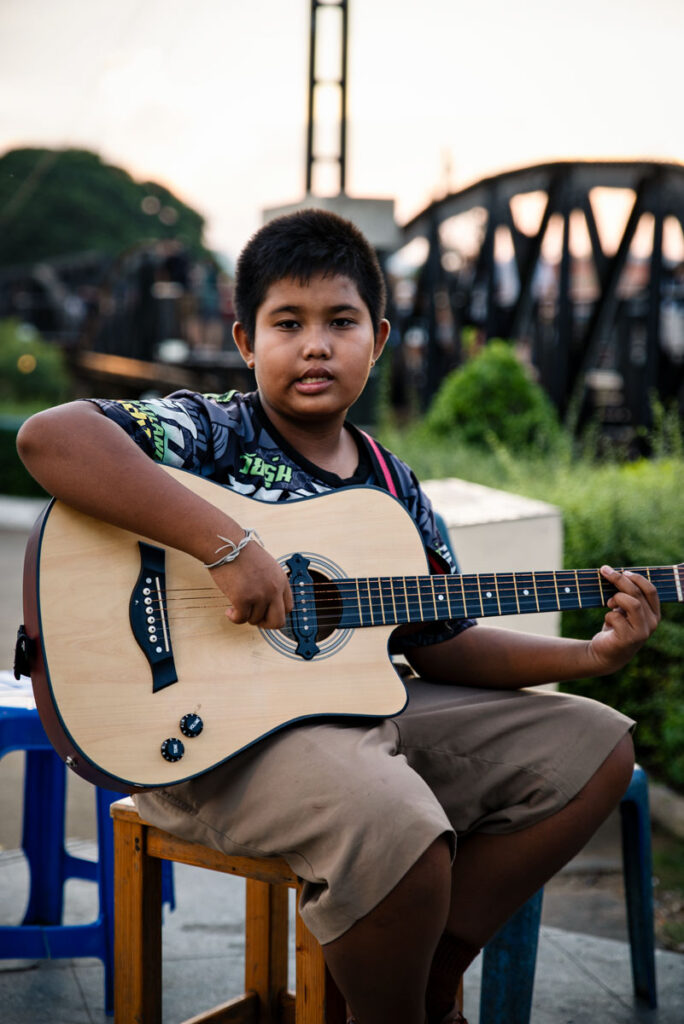
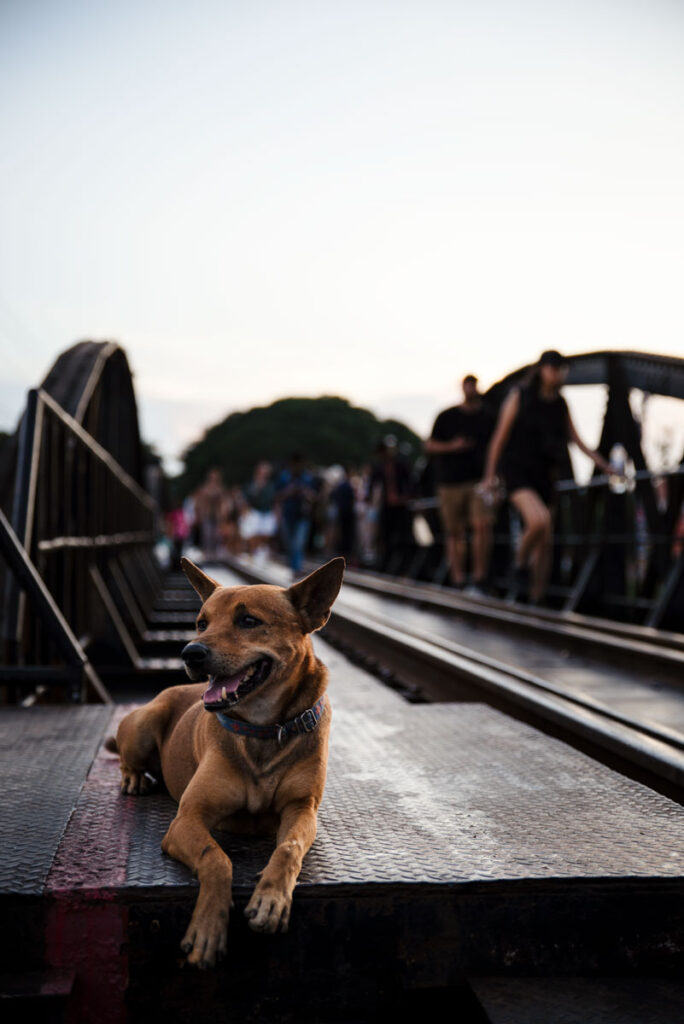
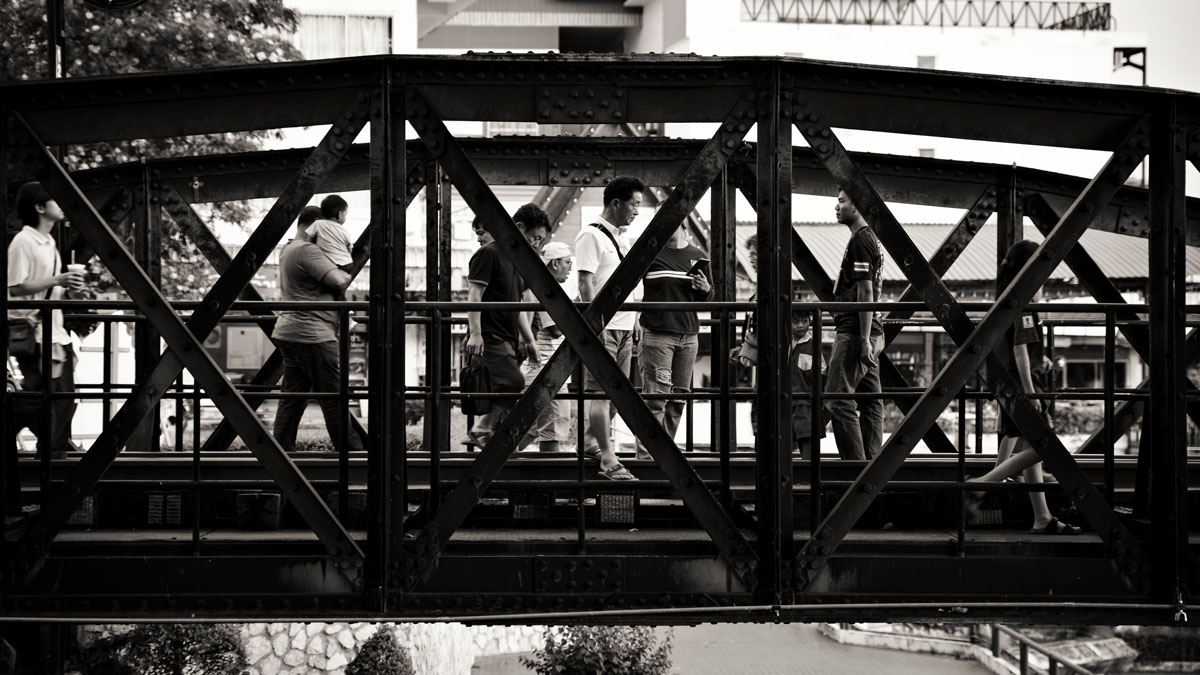
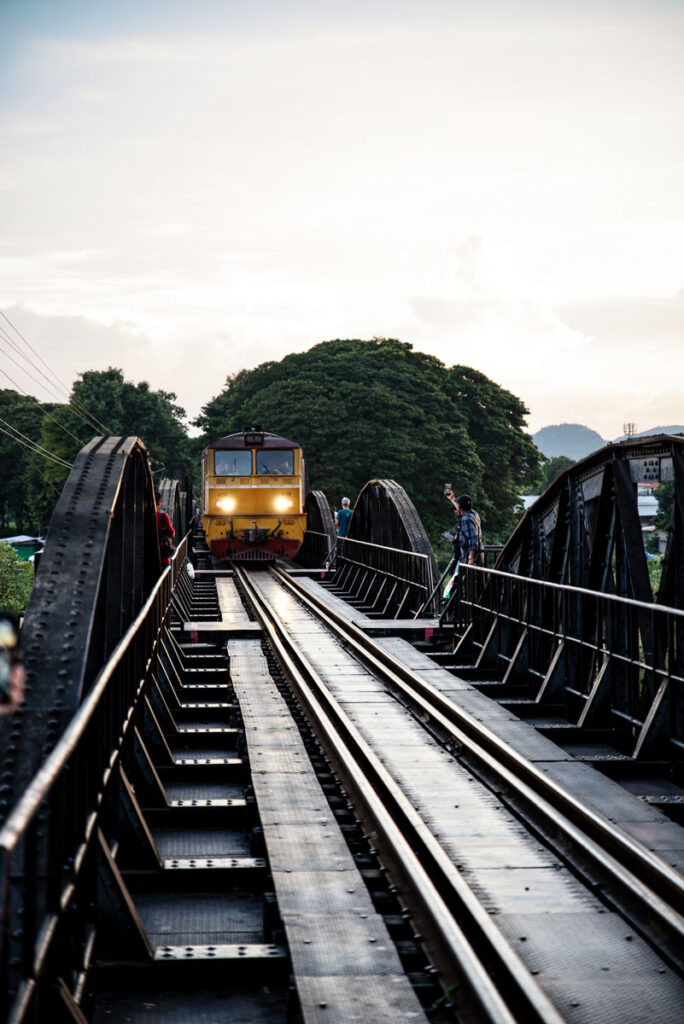
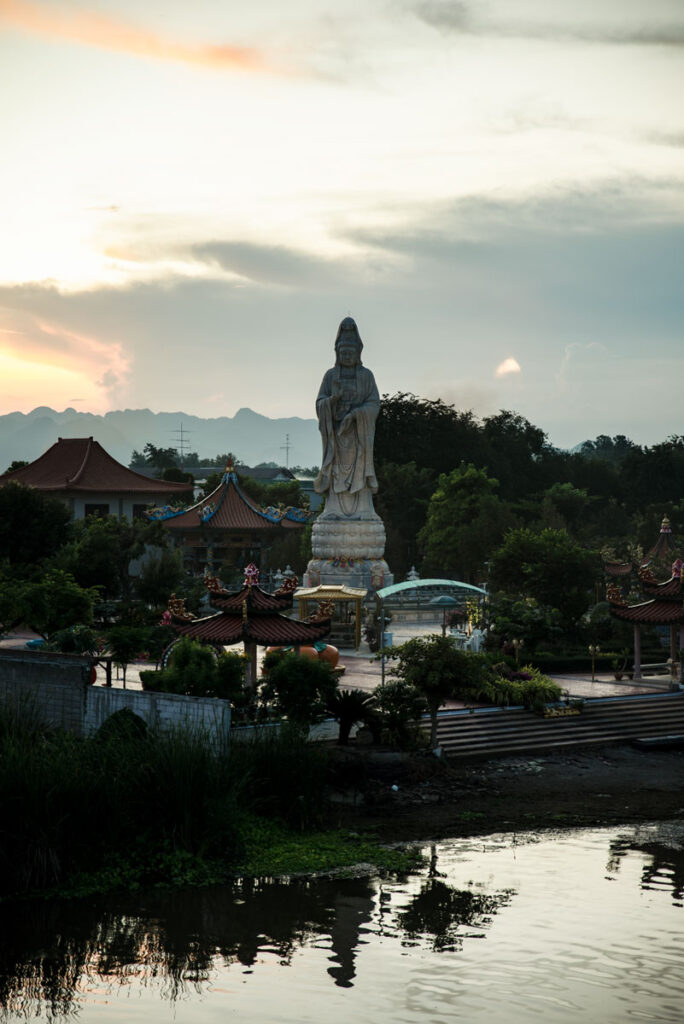
Wide avenues lead to Nam Tok. On one side of the town is the sleepy terminus station. Thais live in simple houses and tranquil alleyways. On the other side of the city, facing the river, there are hotels right on the waterside. We also stay here for a few days, although the town doesn’t have too much to offer. Nevertheless, it is an idyllic place. We dangle our feet in the river at sunset, the water is clear and cold. A flock of birds is startled by a fisherman who skillfully throws his casting net into the water. A new hotel is being built on the other bank – excavators have dug up the embankment and uncovered the red earth.
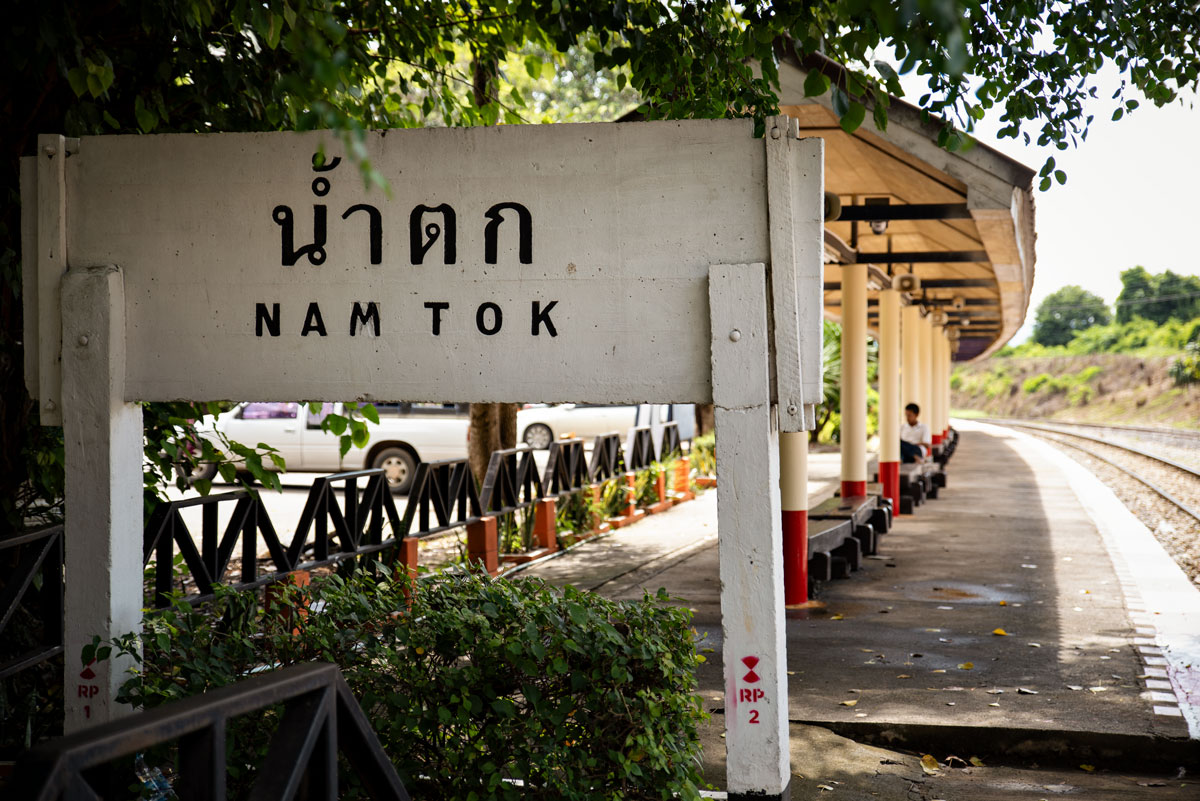
Not far from the small town of Nam Tok lies the Tham Krasae Bridge with the cave of the same name. A popular destination for foreign and Thai tourists. And where there are tourists, there are also stores, restaurants and street vendors. As we get out of the car, a bus with an international tour group arrives. But the vendors remain in the shade of the trees behind their stalls. The electricity is out – so no coffee, no cold drinks. Together with the tour group, we follow the tracks. In the cave, a Buddha statue stands in pale light. A narrow passage leads deeper down. Using flashlights, we try to estimate how far into the cave it goes. We can’t see the end. So back out into the daylight.
Right on schedule, we hear a horn. The tracks vibrate and the leaves of the trees rustle. The train emerges from behind the bend. It rolls past us and other onlookers at a leisurely pace. We wave and passengers wave back. Cheerful serenity. Above us a blue sky, below us the Khwae Noi. Many innocent people gave their lives to lay these tracks. The trains once transported supplies and weapons from Japanese-occupied Thailand to Burma. Today, there are happy adventure seekers and selfie stick-wielding backpackers.
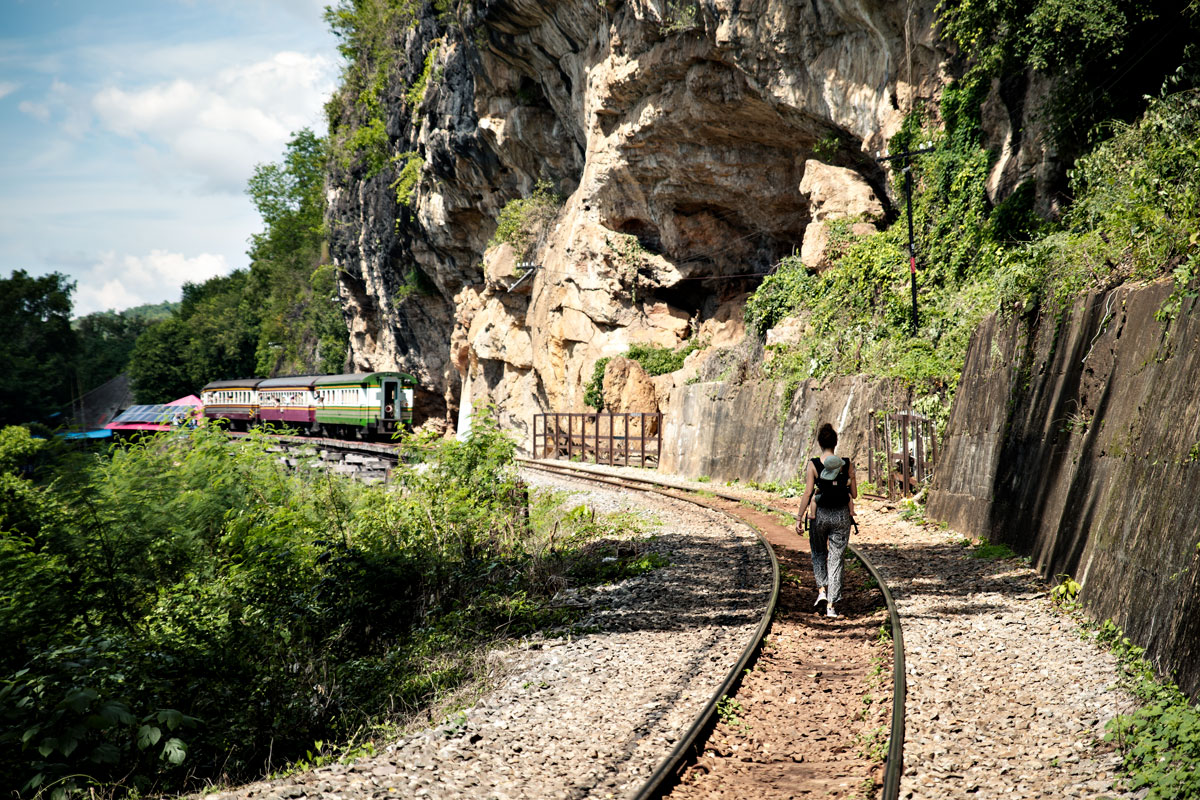
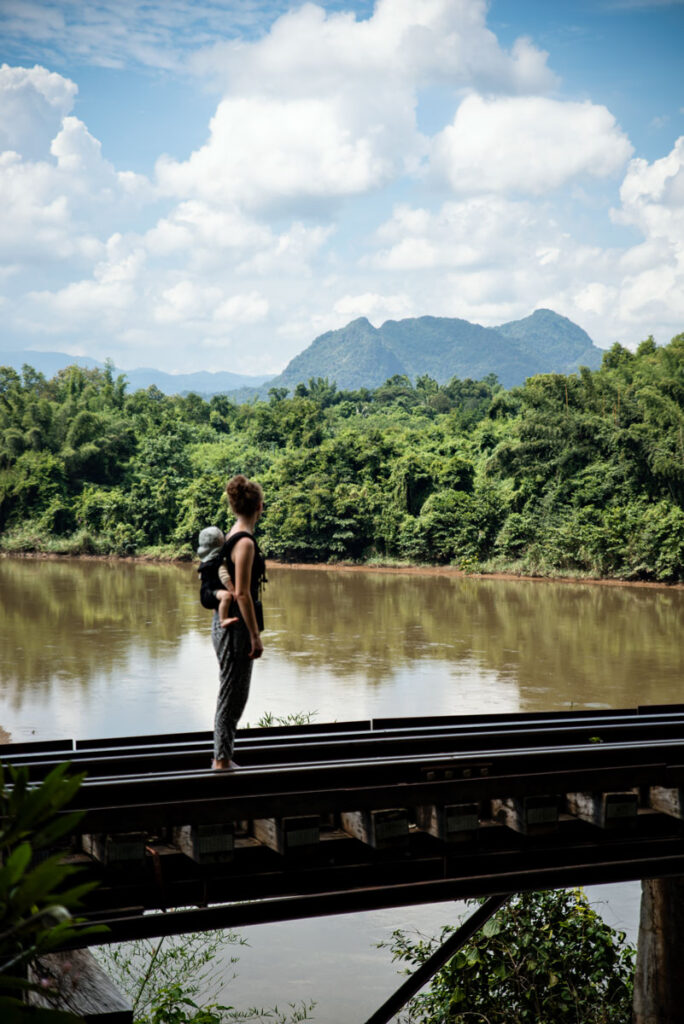
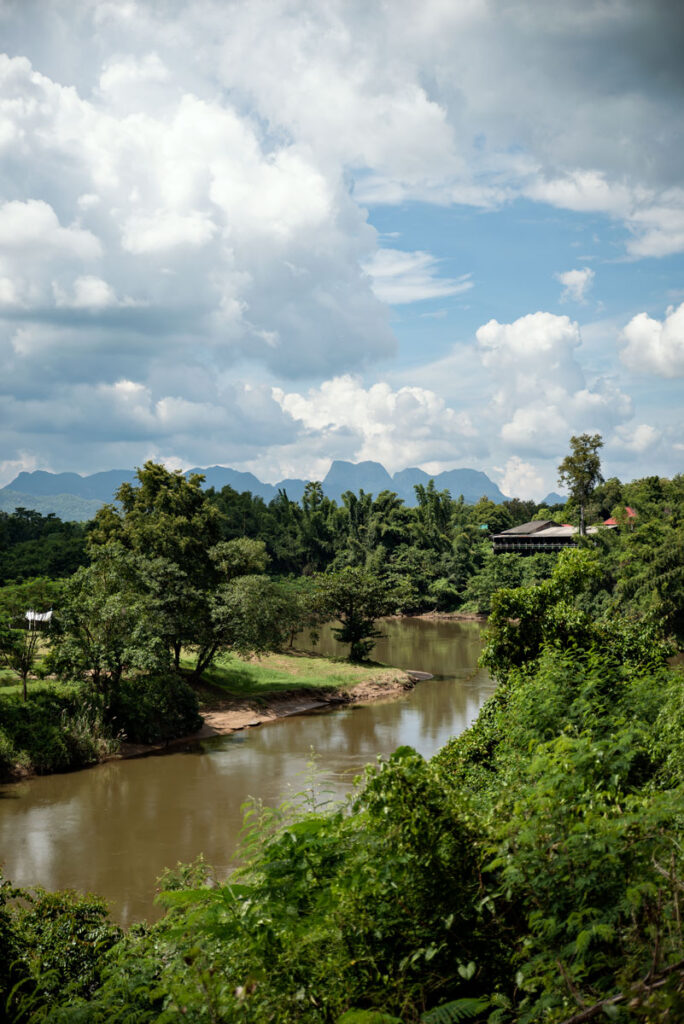
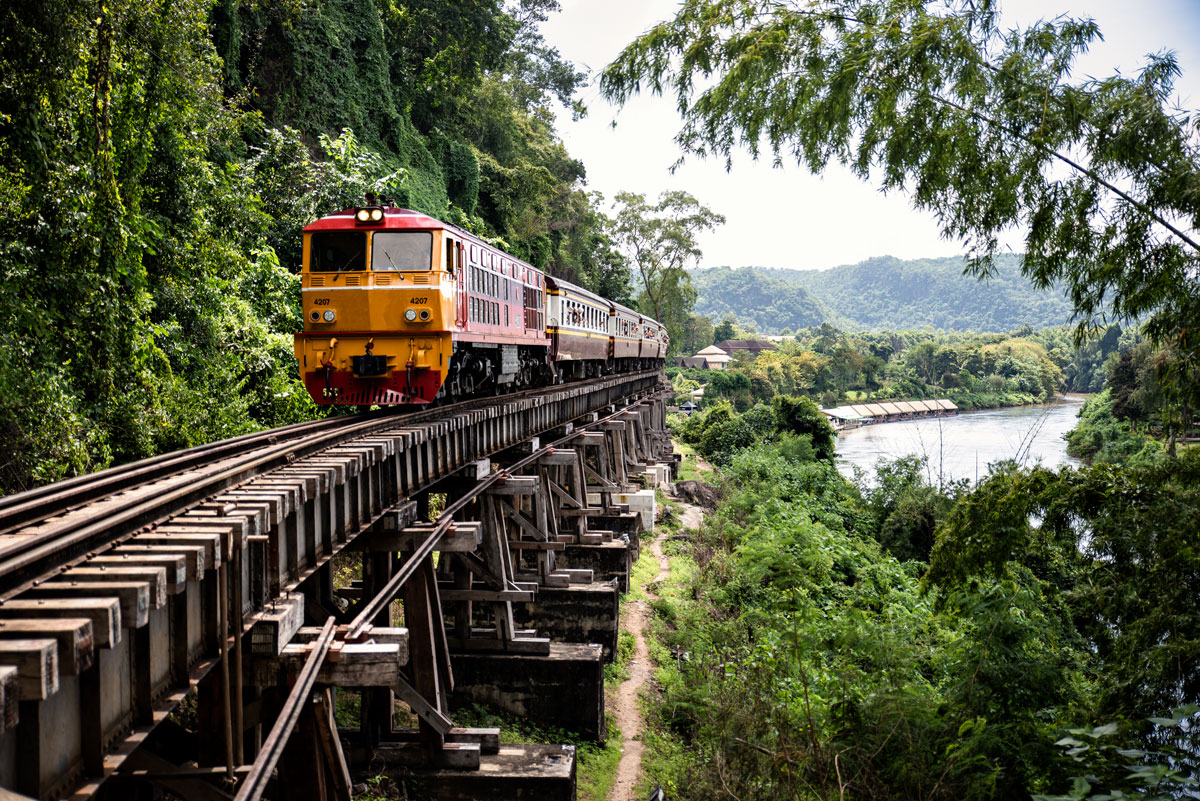
Bamboo grows thickly. Butterflies dance in the air. Large cloud formations drift across an endless sky. Ranges of hills rise like ramparts on the horizon – behind them lies Myanmar. Dense jungle stretches all the way there.
We walk through the narrow gorge of the Hellfire Pass. The granite, through which people had to dig with the simplest of tools, rises over twenty meters high to the sides. Traces in the stone and a broken drill bring the past to life. We are overcome by a cold shiver when we reach a monument at the end of the gorge. The flags of the nations whose men died as slaves on the Death Railway are taken up by a gust of wind. The cloud formations push in front of the sun. Suddenly rain falls. At first we seek shelter under a dense palm tree, but when the rain turns into a veritable monsoon, we rush back to our car.
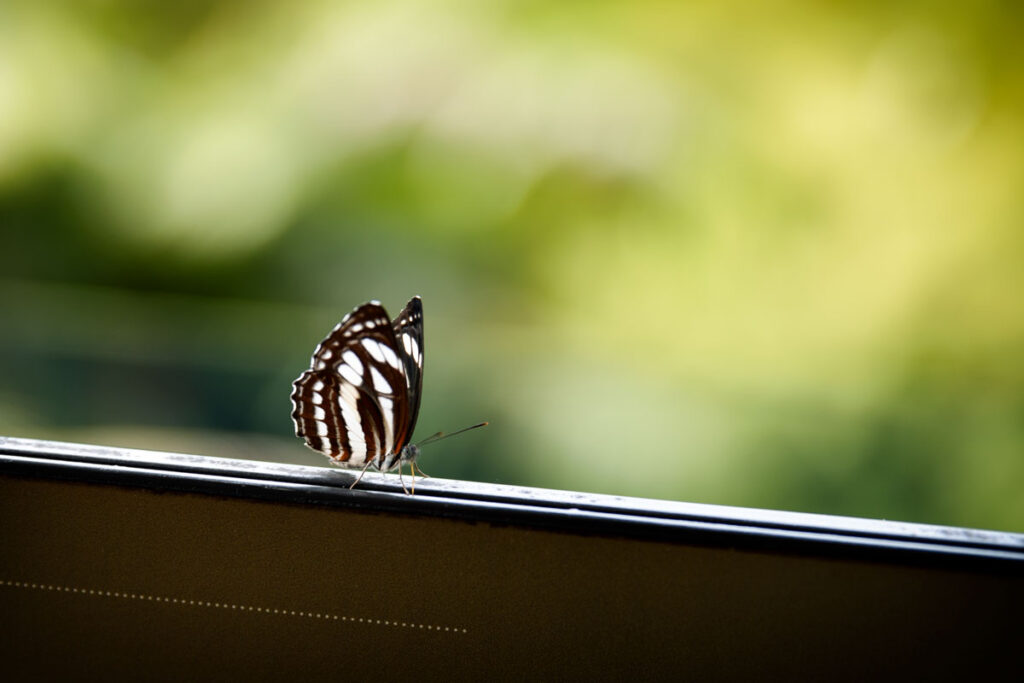
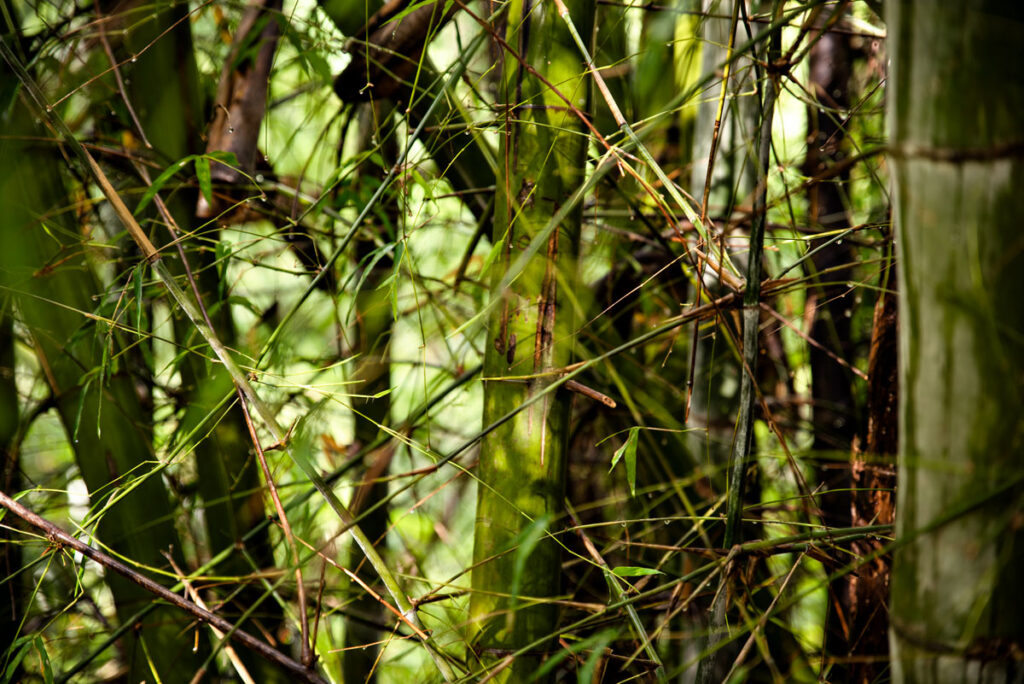
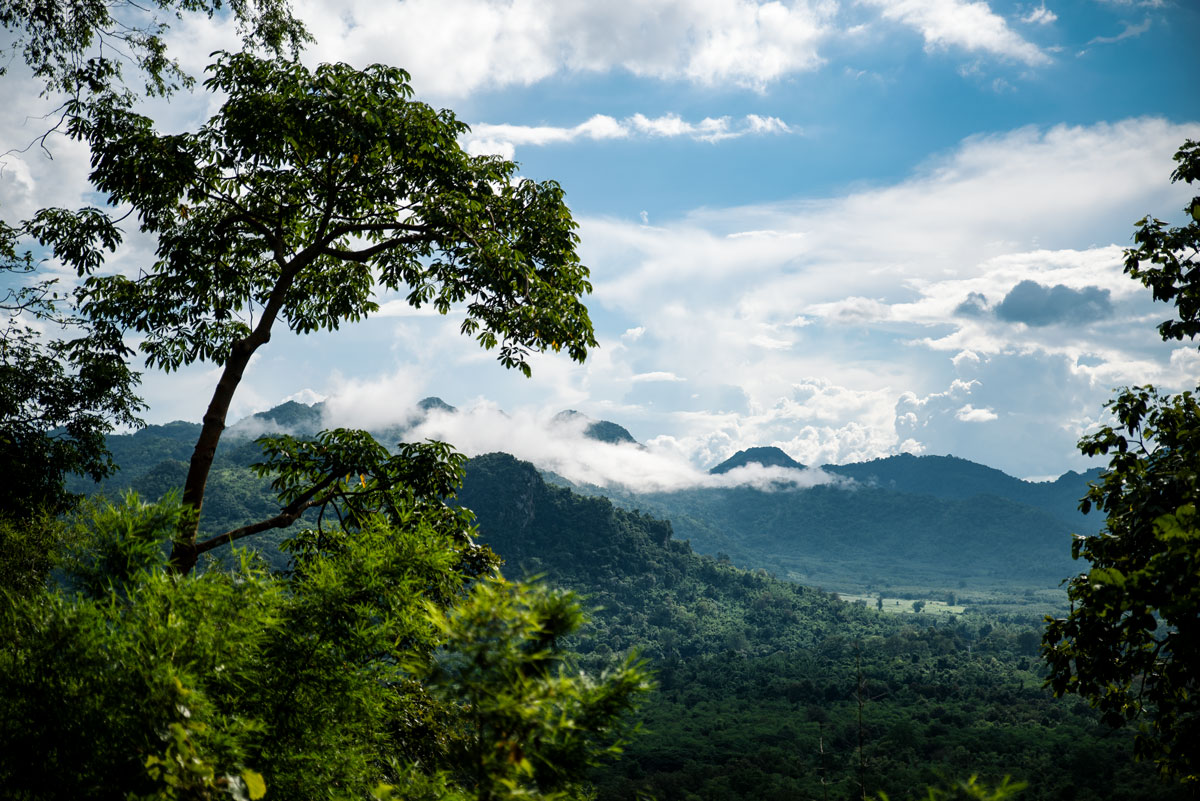
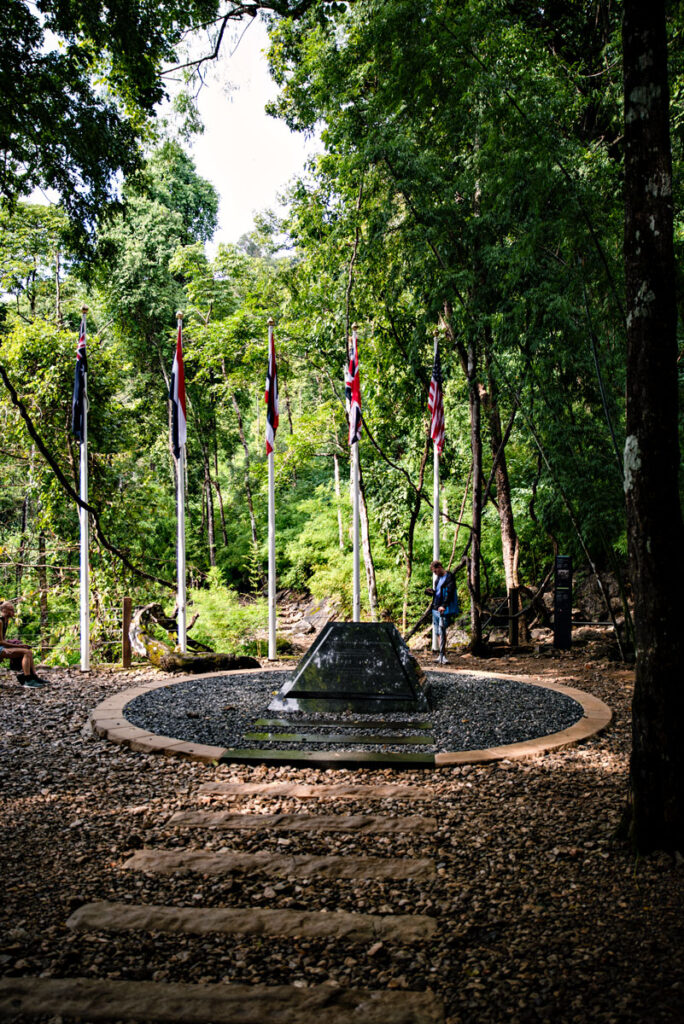
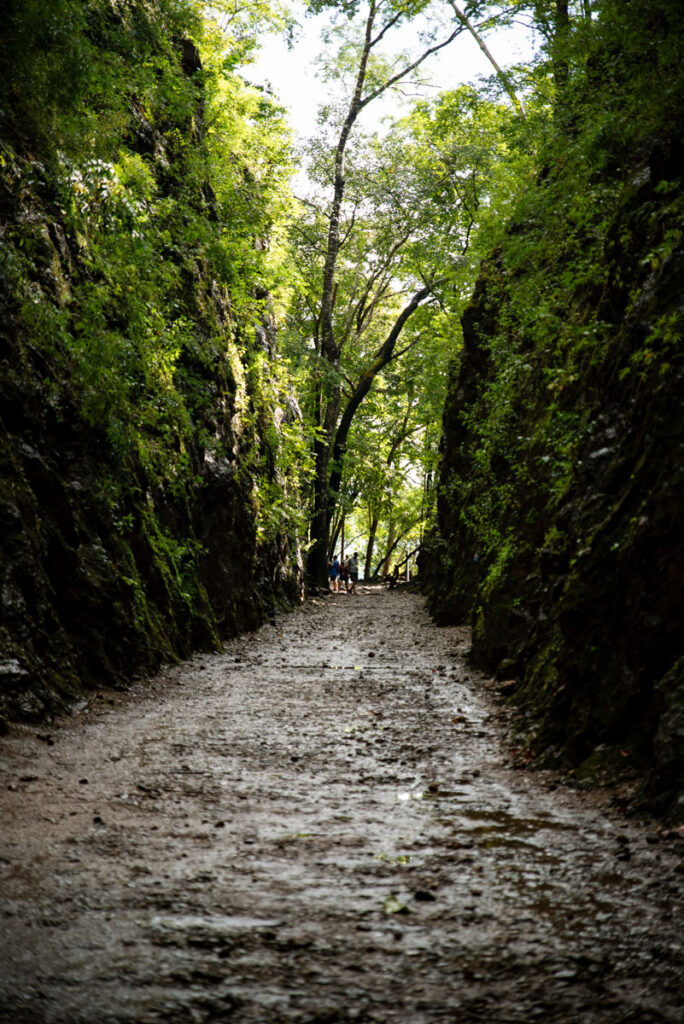
We get deeper and deeper into the province. The jungle around us becomes denser, the roads narrower. Foreign tourists rarely come this far. We are the only ones at the Kroeng Krawia waterfalls. In contrast to the crowded Erawan Falls, it is quieter and more idyllic here. We follow a short path along the water. Again and again we see garbage: cigarette packets, Coke cans, plastic bags. If mankind still exists in 1,000 years’ time, it will suffocate on its own garbage by then at the latest.
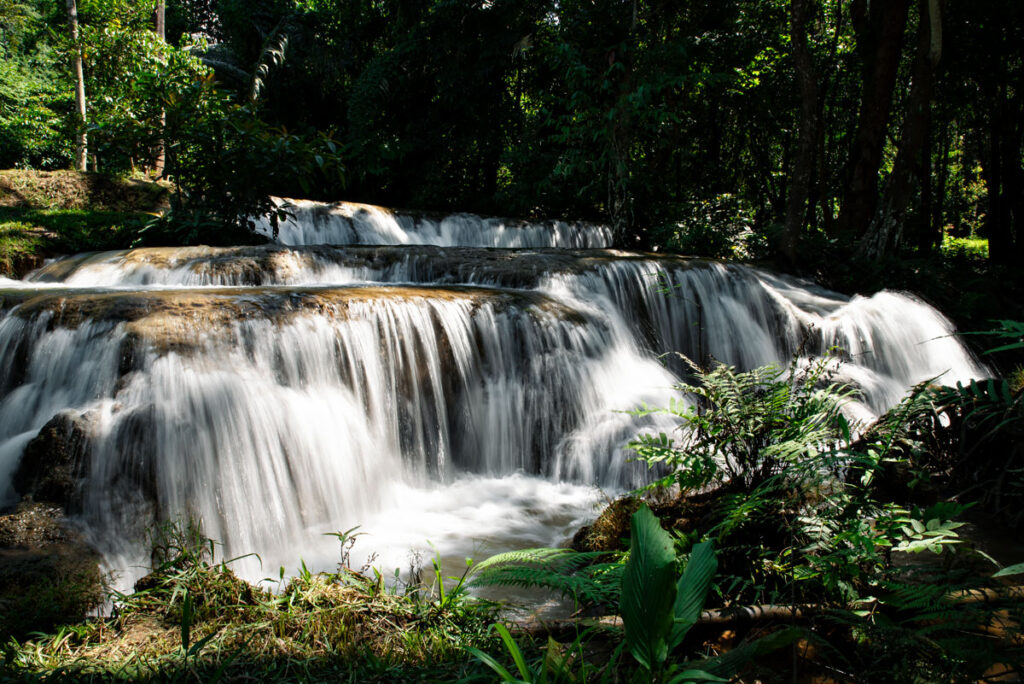
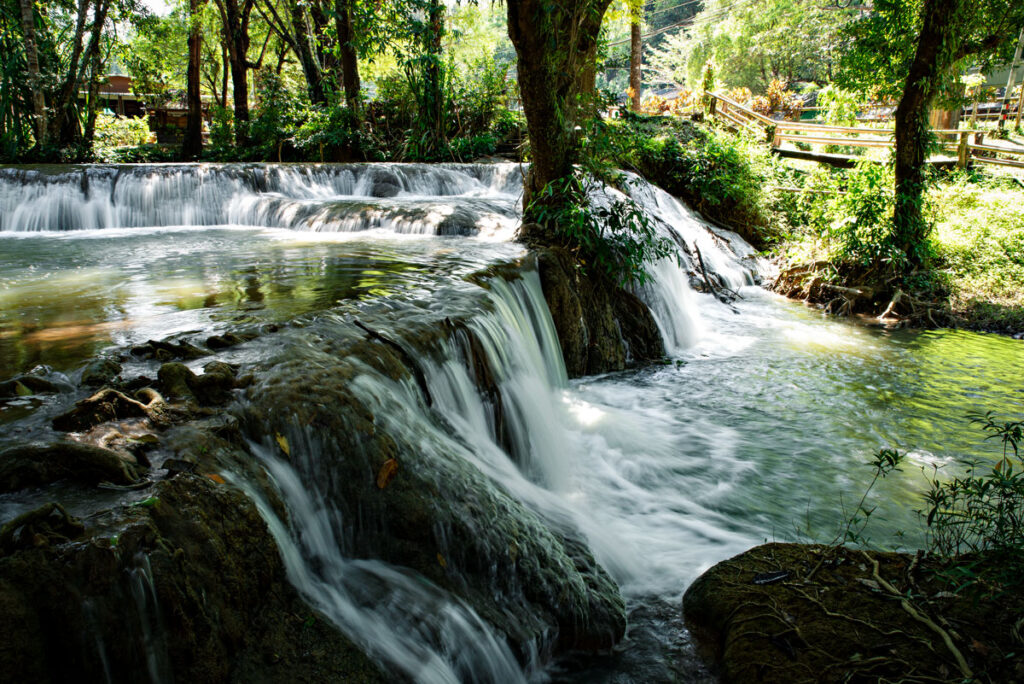
The closer we get to the border with Myanmar, the more frequent the security checks become. The last one is particularly thorough; there are occasional fights and acts of war on the Myanmar side. Then there it is – the border. And with it the Three Pagodas Pass. In the Tenasserim Mountains, the pass is one of only a few possible crossings. A gateway to Thailand. It is said that Buddhism once reached Thailand from India via the Three Pagodas Pass. When Ayutthaya was a powerful capital, Burmese troops used the pass to make advances into the Kingdom of Siam. Finally, the Japanese railroad from Thailand to Burma also passed through this pass.
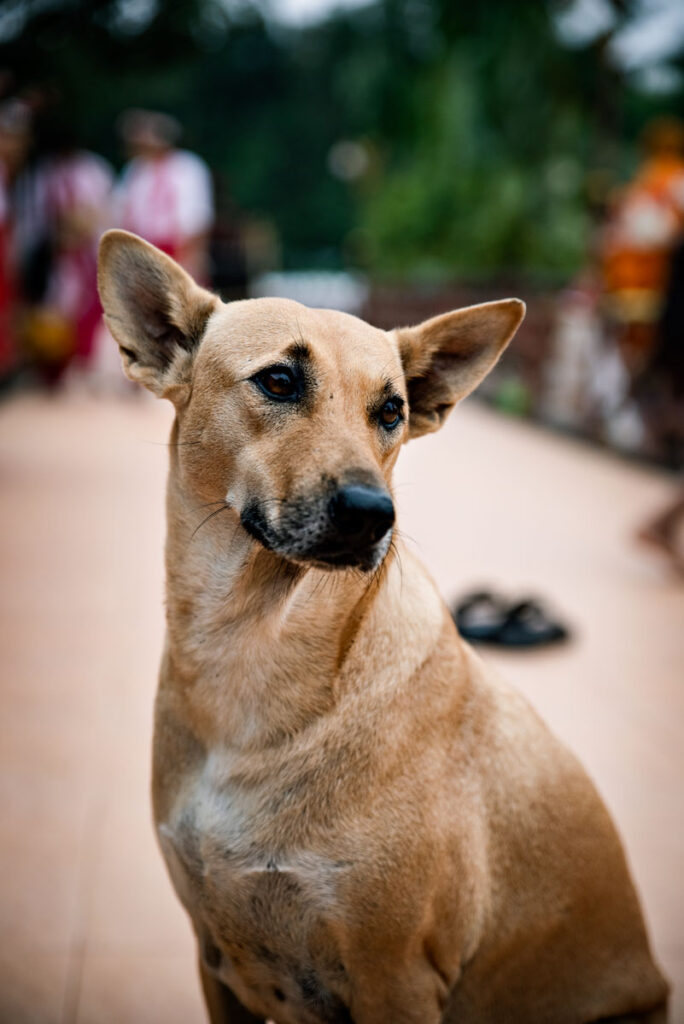
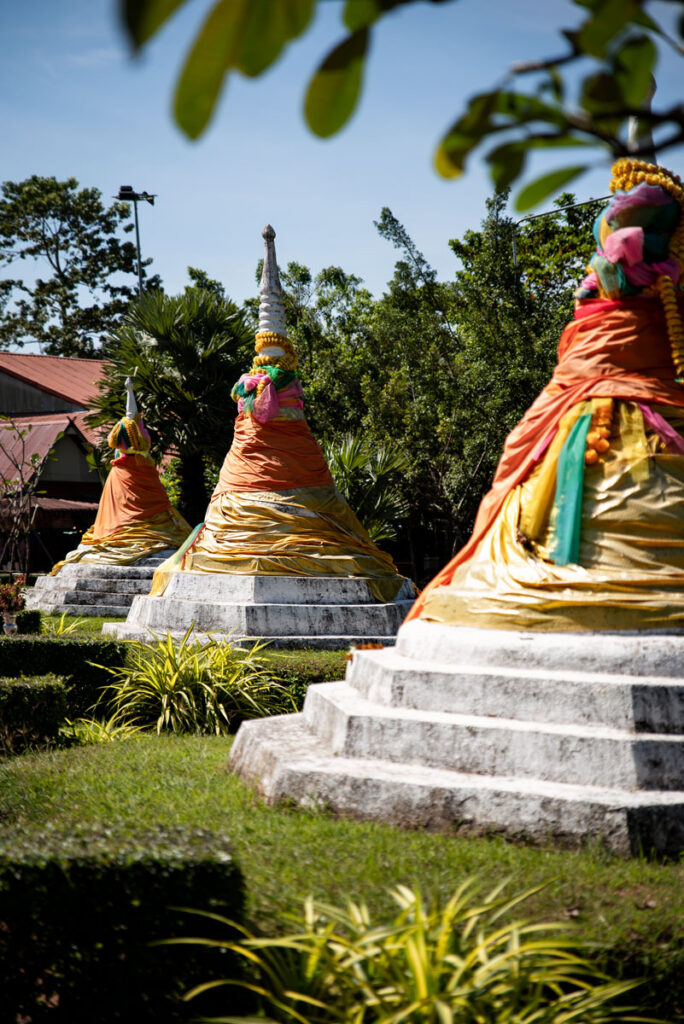
We arrive in Sangkhlaburi just before dark. Dusk falls over the artificial reservoir. Weather glow over a gigantic Buddha statue. Twilight of the gods.
When the dam was built and the water backed up behind it, it flooded villages and temples. When the water level is low, the tops of the temples protrude from the water.
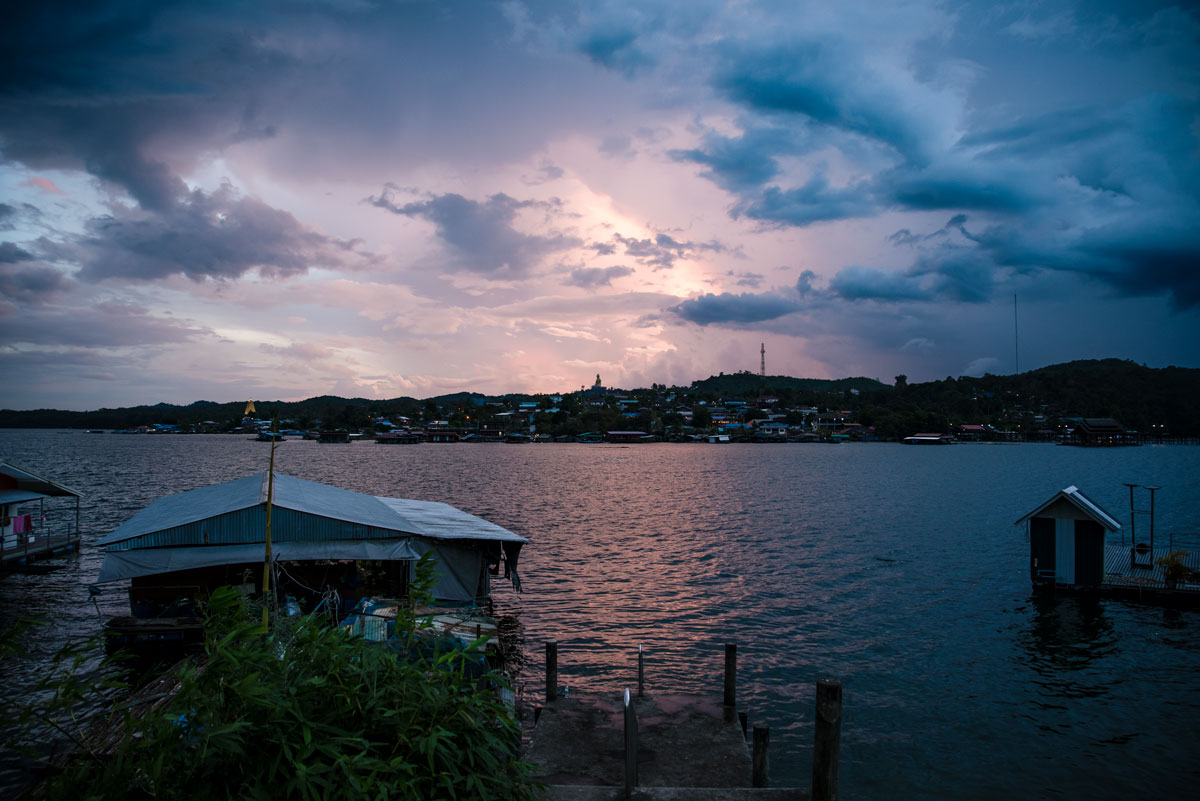
Sangkhlaburi wakes up before sunrise. Dressed in traditional Mon clothing and their faces painted with thanaka, the tourists flock to the wooden bridge. It connects the small town of Sangkhlaburi on one side and a Mon village on the other. Locals and tourists line up in a long row. Monks pass by and accept donations. Rice, shower gel, a toothbrush, some money or a pack of cookies. Things for everyday use. As the monks pass by, a woman clears away the tables and chairs that had just been loaded with donations. The sun rises higher and the streets empty as if the morning hustle and bustle had never happened.
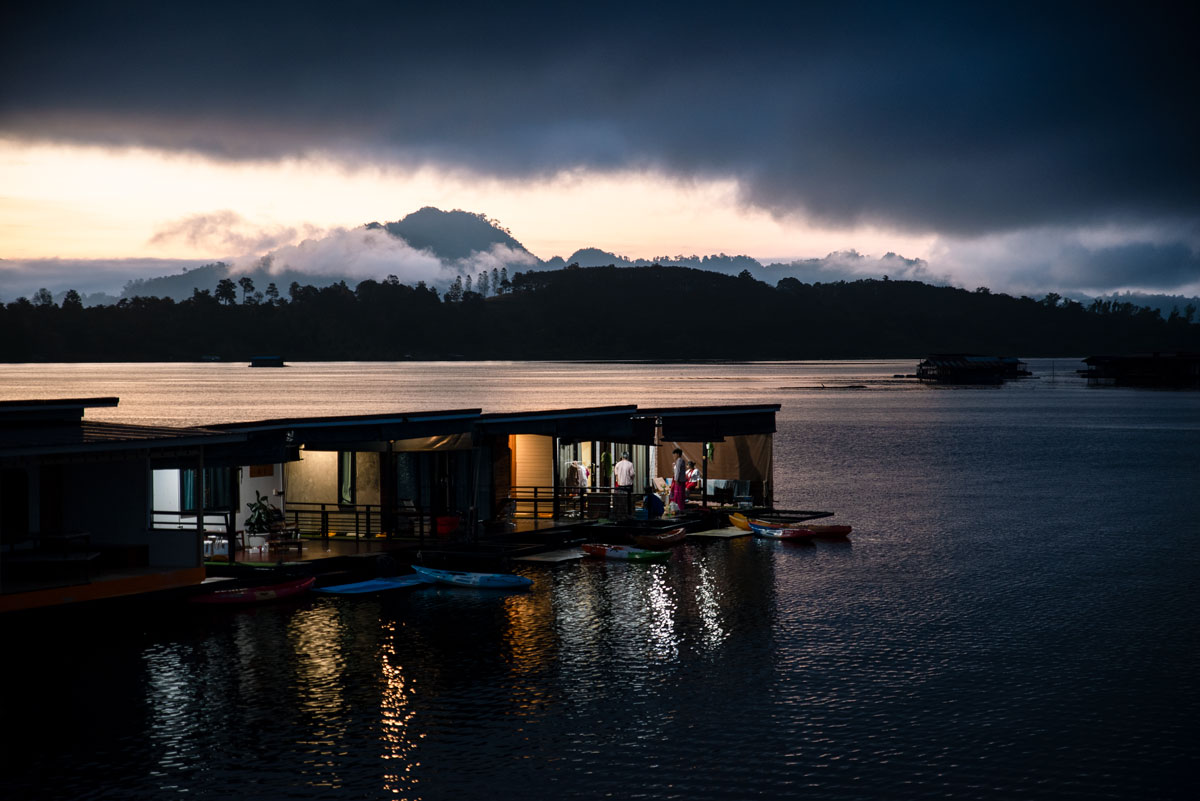
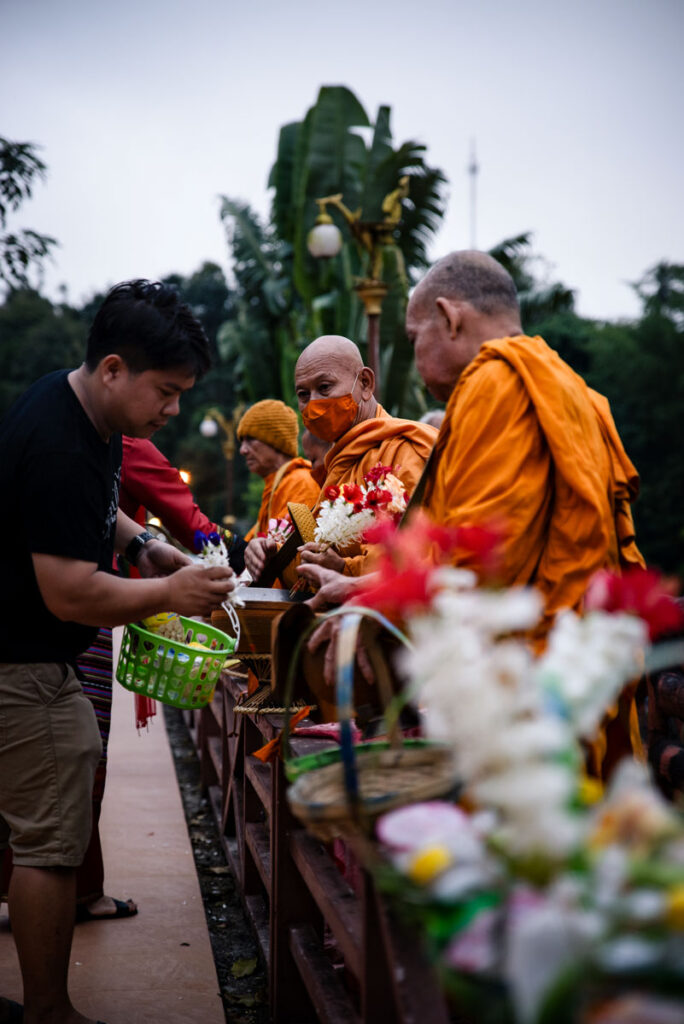
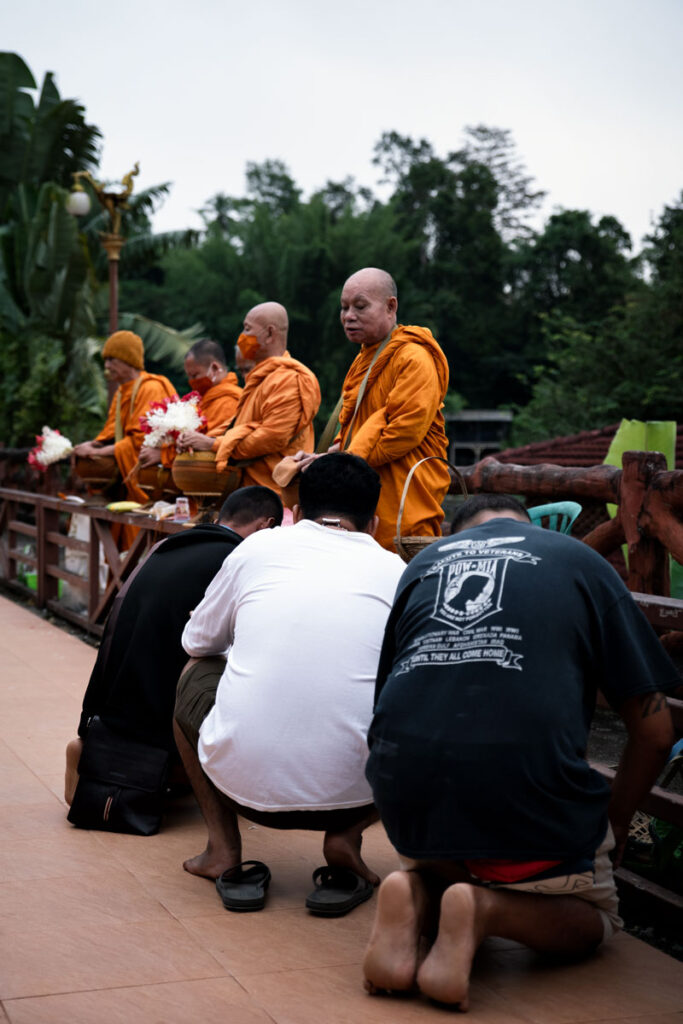
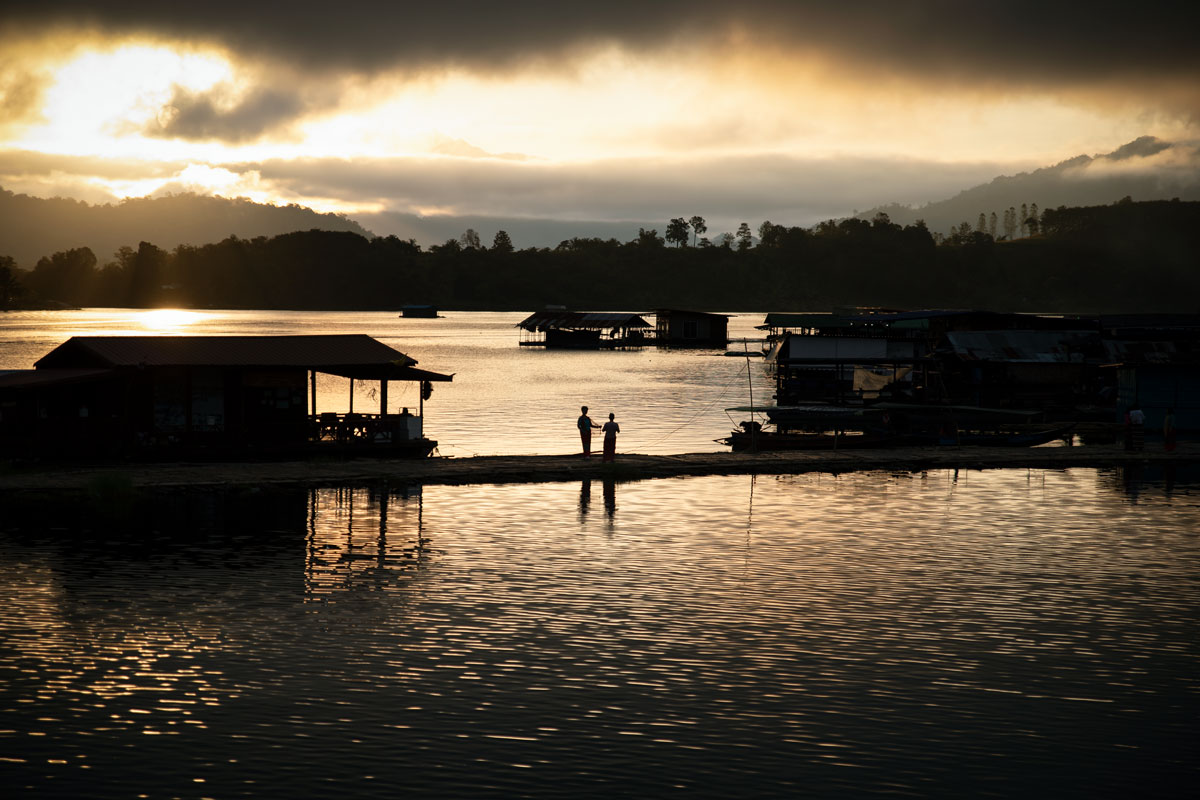
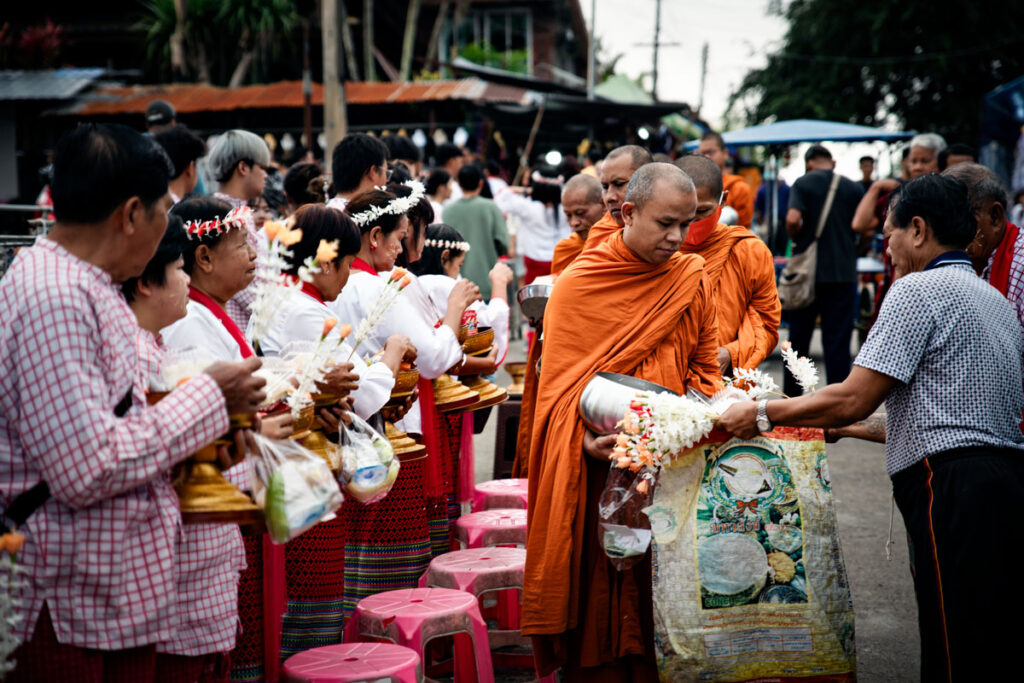
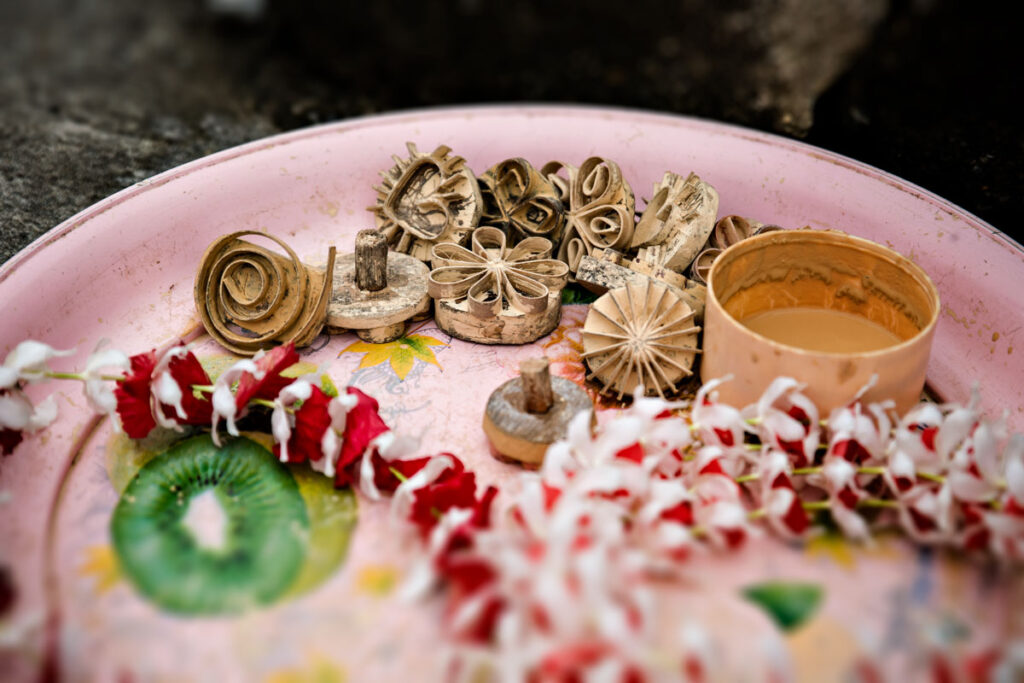
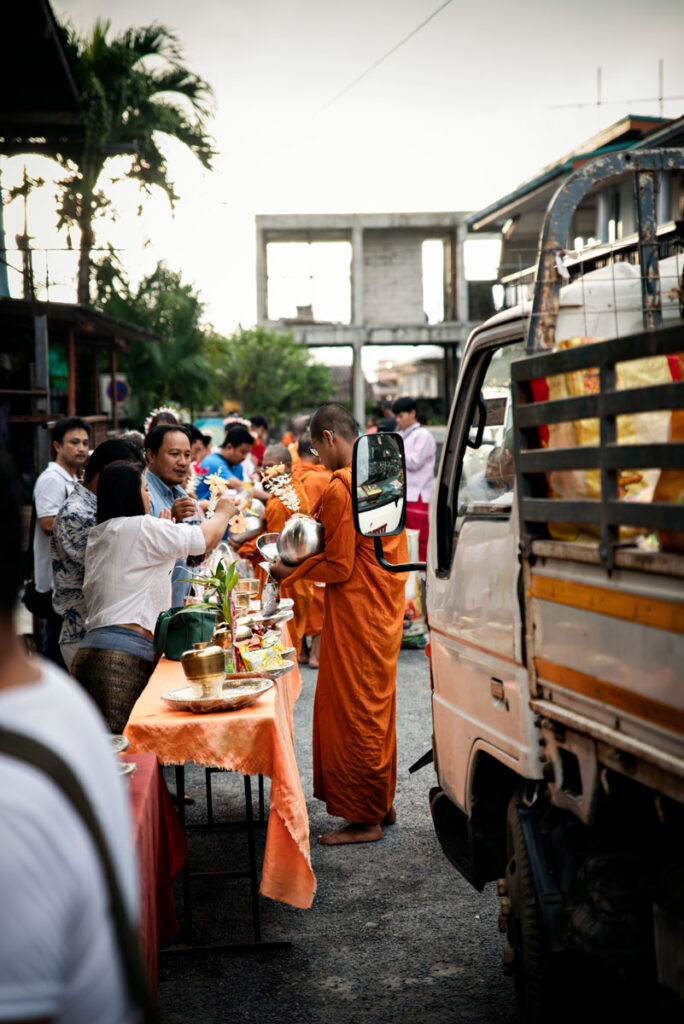
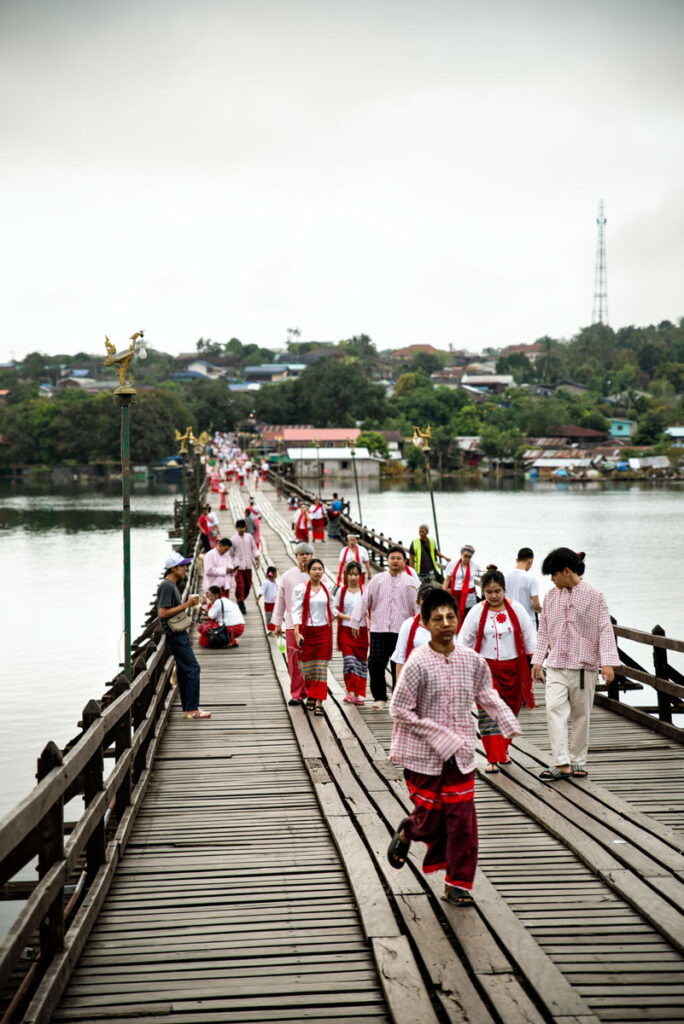
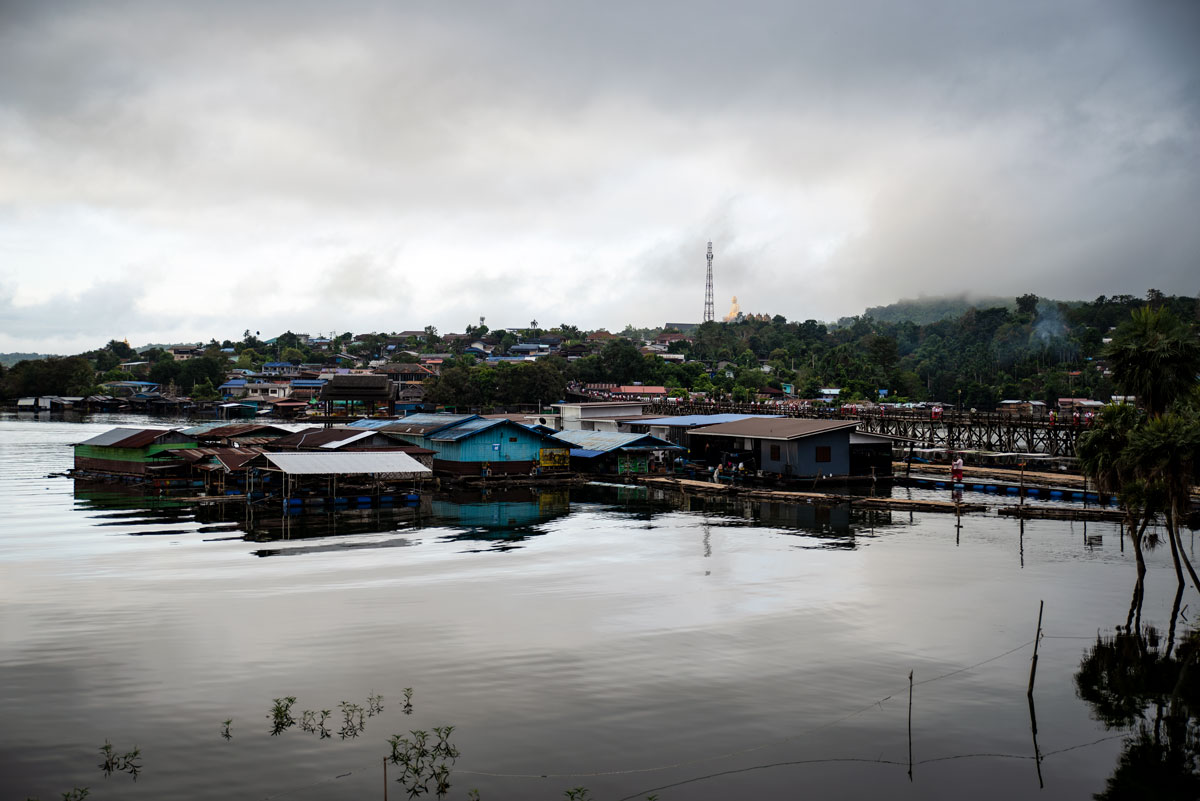
After a simple breakfast with our Thai hostess, we want to explore the gigantic Buddha on the Mon side of the city. We park our car at a simple and old monastery. The monks have hung out their robes to dry. Then we follow a new, narrow road.
The gold-painted Buddha is reflected in the water of a lake. It has become hot. In the shade of a tree, an old man sweeps leaves off the asphalt. He takes his time, drinks a sip, then sits down and smokes.
We are always looking for new places, driven by an inner restlessness. We need more and more new places to be happy. As we follow the steeply ascending road in the midday heat, the old man spends his days in the shadow of the sacred statue. His task is a never-ending one, for as long as trees grow here, leaves will fall. His life seems more relaxed than ours.
Arriving at the statue, a monk nods to us before turning his attention back to a television program. We only enjoy the view of the lake and the wide valley for a short time; the golden Budda reflects the sunlight and makes it impossible to get too close.
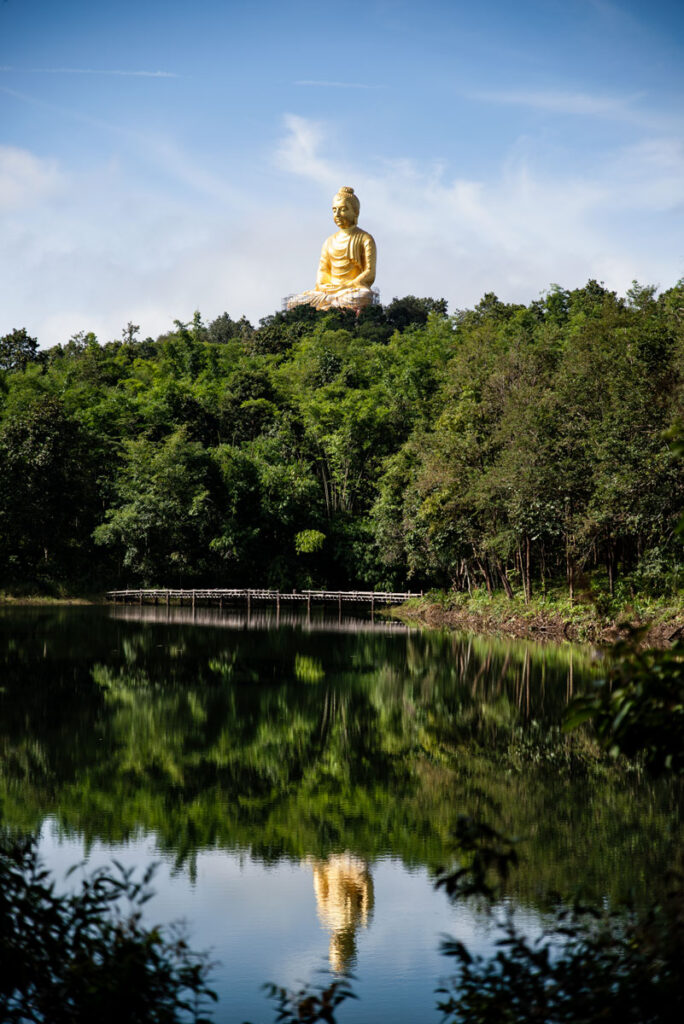
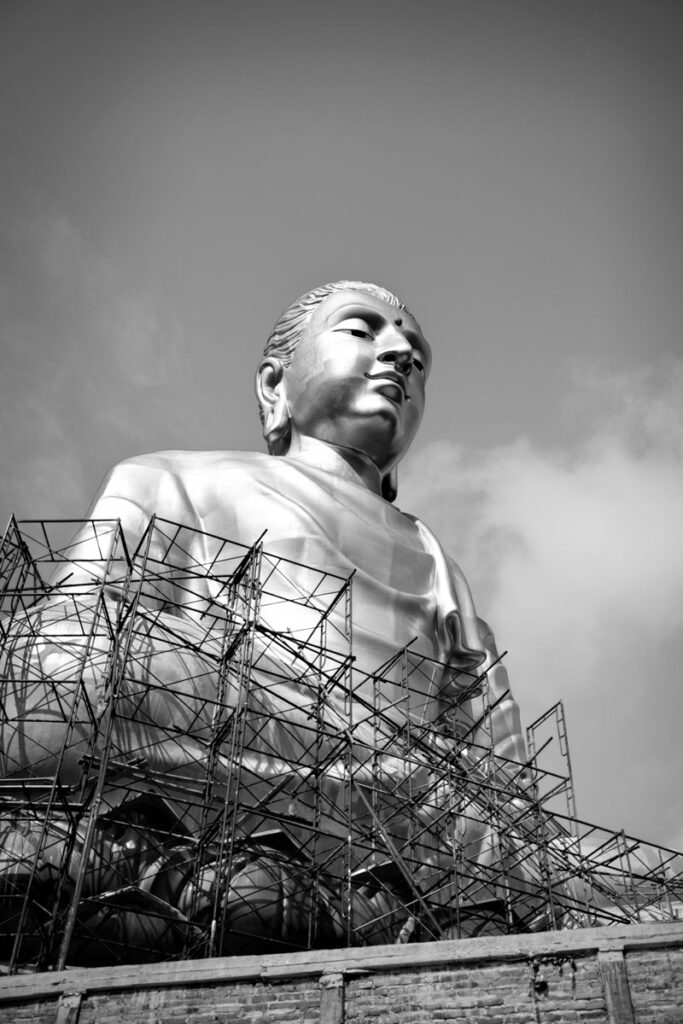
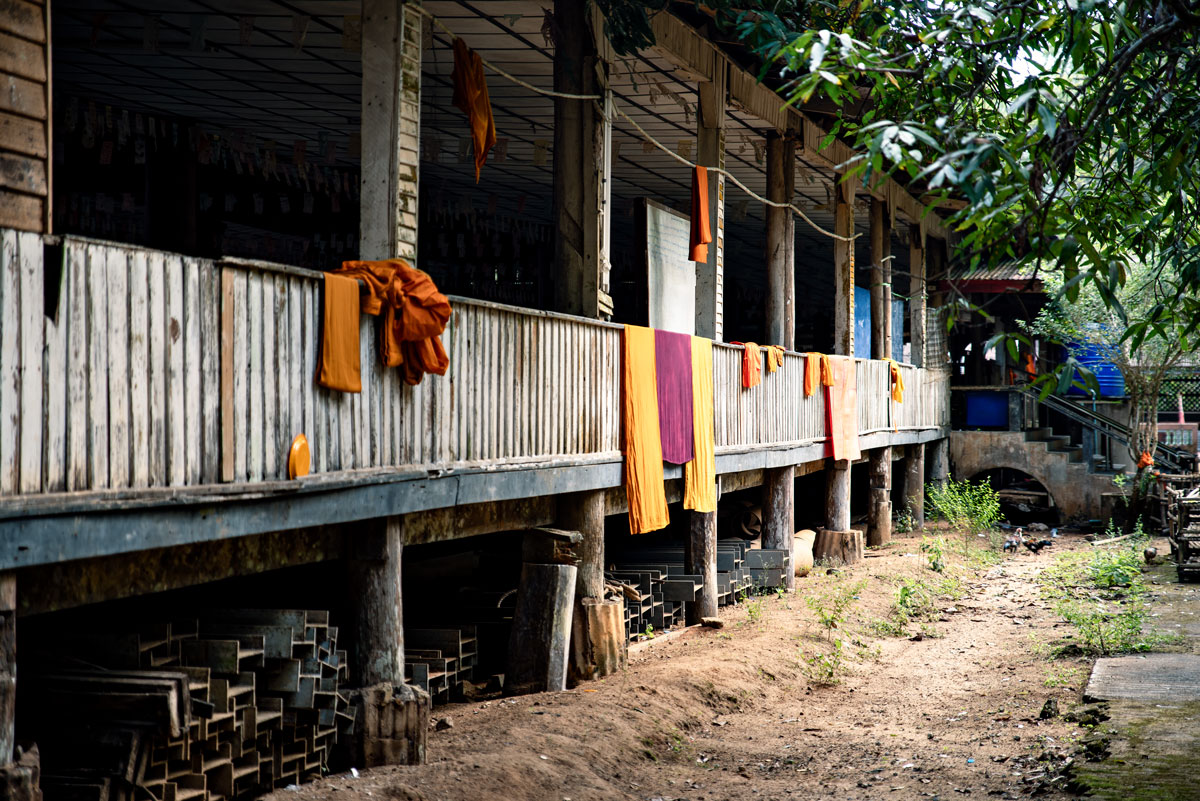
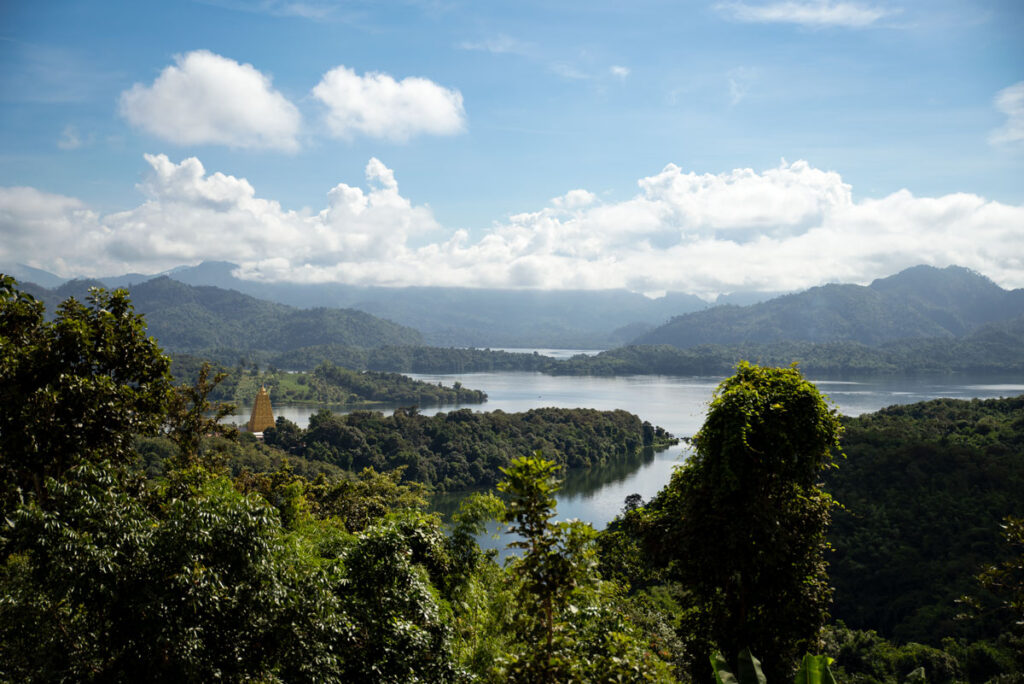
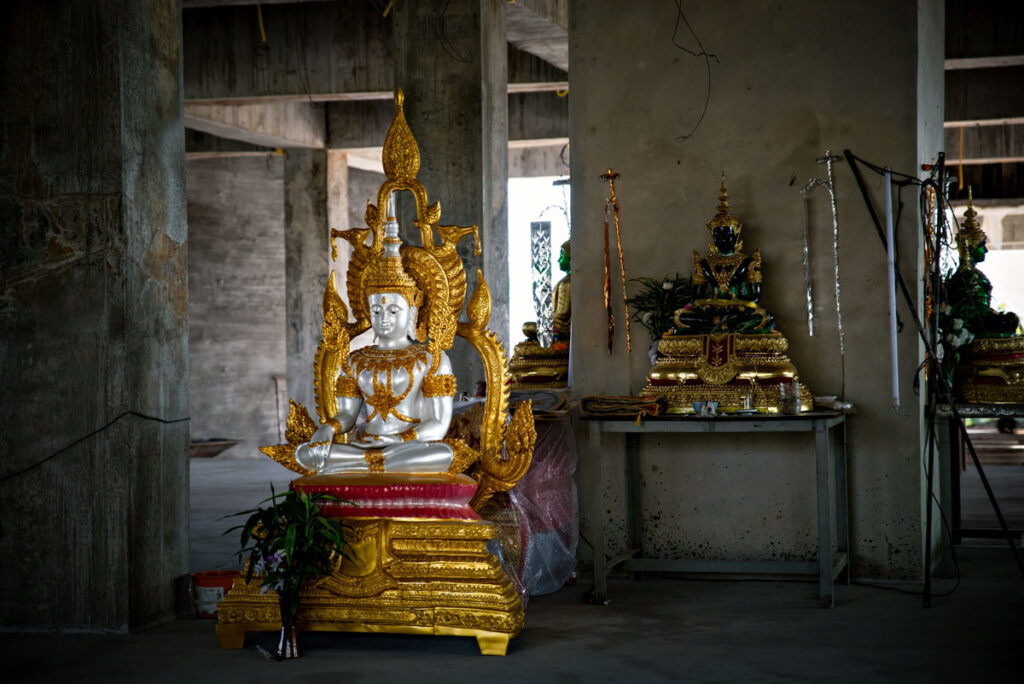
It’s time to set off. But before we leave Kanchanaburi province, we turn right off the main road, cross the Mae Klong, the united river of Khwae Noi and Khwae Yai, and wind our way through narrow alleyways in a village. A colorful jumble of temples and shrines suddenly rises up on a hill in front of us. A steep and long staircase leads up to the Tiger Cave Temple.
Surrounded by lush green rice fields, Buddha sits in the Vitarka Mudra posture. His gaze is directed towards the meandering river. The tower of a Chinese temple rises up next to him. Prayer bells ring out. Thais kneel down and say a prayer. A folded bill for a donation. The Buddha statue is to be restored.
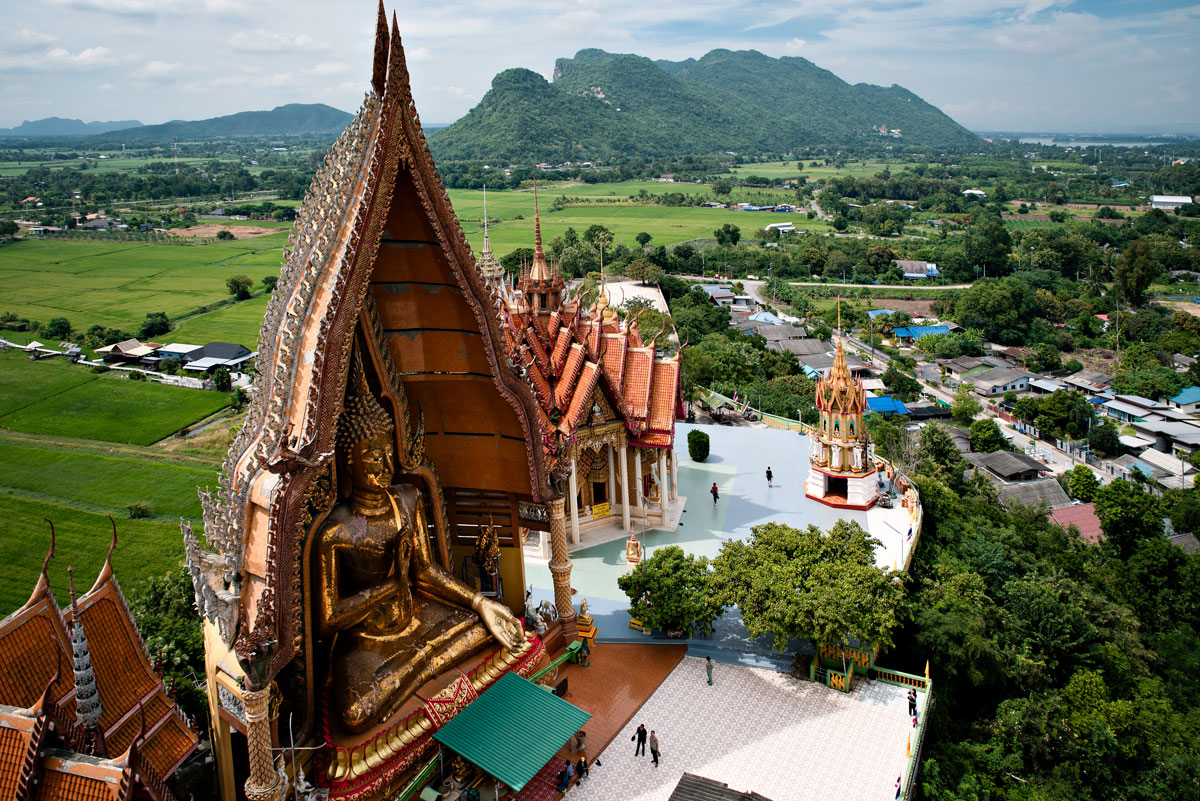
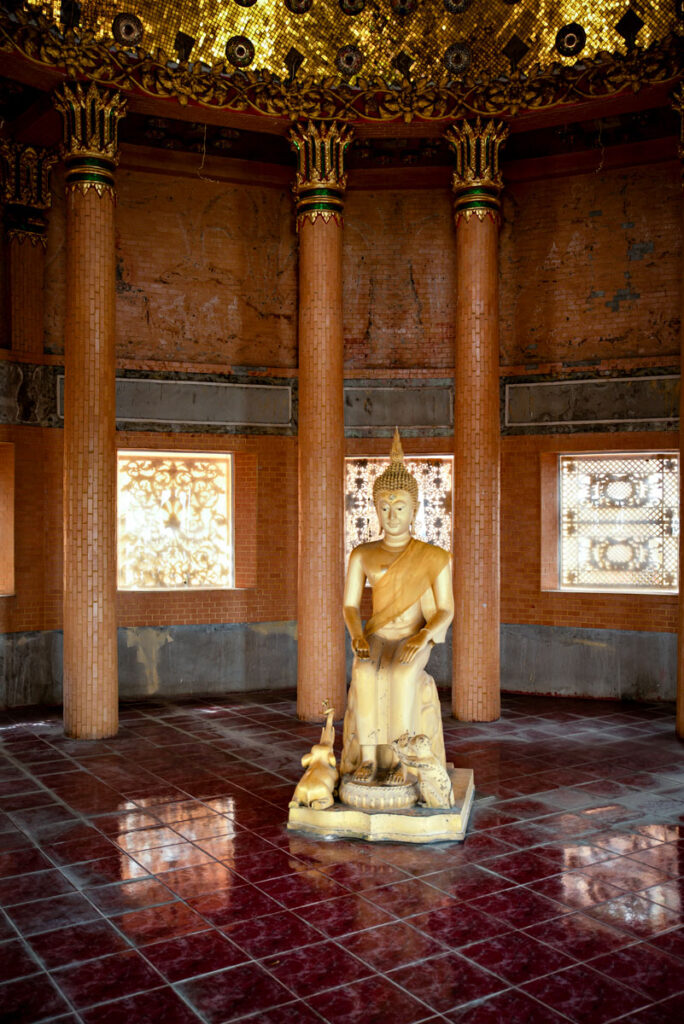
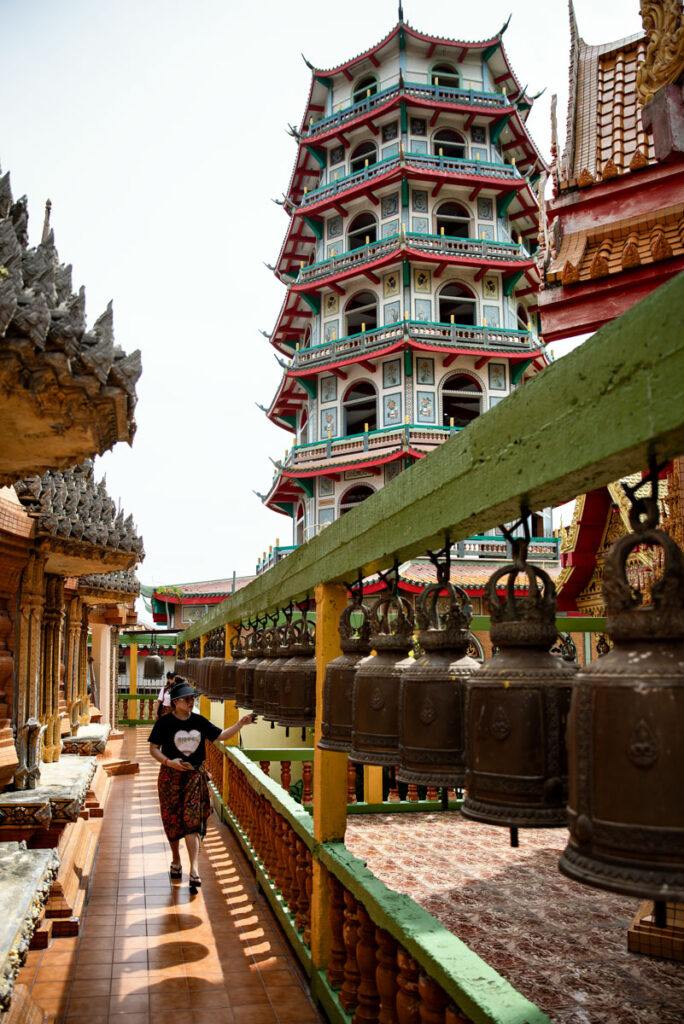
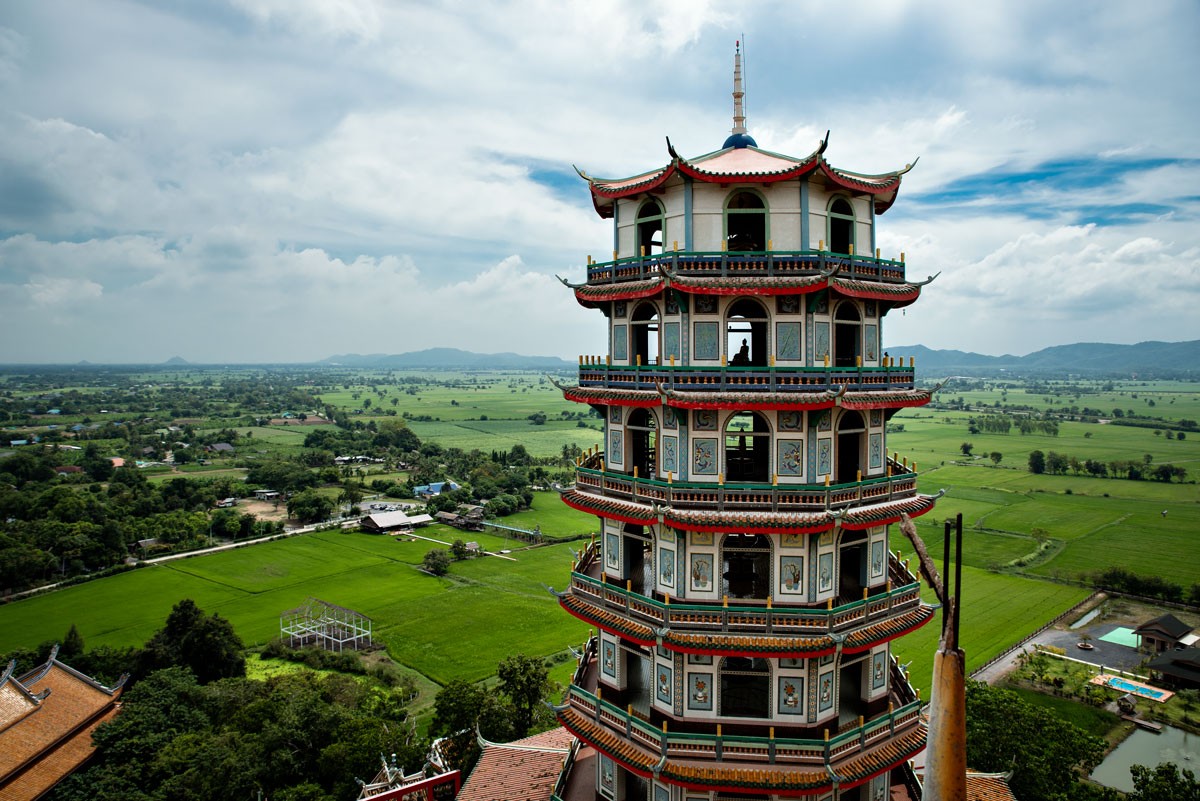
And then we leave Kanchanaburi. We have traveled up and down the province once and believe we have by no means seen everything. We have fallen in love with the rivers and the railroad, the rolling hills and the green jungle. The magical Sangkhlaburi enchanted us and the morning at the Mon Bridge was one of the most beautiful Thai experiences for us.
Info about our trip
Kanchanaburi is one of our favorite provinces in Thailand. You will find a good tourist infrastructure along the railroad line as far as Nam Tok. Beyond that, the province is less populated, more mountainous and more pristine. It is definitely worth traveling as far as Sangkhlaburi and getting up early there – the highlight of the trip for us. Most tourists travel by train from Bangkok to the city of Kanchanaburi or to Nam Tok. This is certainly a very nice route, but we followed the route by car as we had our little man with us and preferred to take photos of the train rather than from it 😉
Nam Tok – the terminus of the railroad line – doesn’t have much to offer apart from beautiful resorts right on the water; perfect for relaxing after a few days in the jungle and a nice change from the usual beach hotels. In general, the following can be said about Kanchanaburi: If you want action and adventure in nature, Chiang Mai is the better destination for you. If you are interested in the history of Thailand and trains, then you are in good hands here!
Kanchanaburi is quite cheap and it gets cheaper the further north you go.
The taste of the food in Kanchanaburi is definitely different to the rest of Thailand. There is pumpkin on the menu, snails too and the spices are generally different. Maybe it was because we couldn’t find any good restaurants, but we didn’t like the Thai food in Kanchanaburi. Instead, we have two tips for international cuisine: in the city of Kanchanaburi, a Swiss man runs a pizzeria that serves really good food. Great (!) vegan cuisine (also for non-vegans and vegetarians) is available at On’s Thai-Issan Vegan. And in Sangkhlaburi there is a really good Korean restaurant, Lee’s Kitchen, which we highly recommend.
In Kanchanaburi, we recommend The Bridge Residence Hotel. Well located, clean and with a pool. Plus a great breakfast!
If you’re planning a stopover in Nam Tok, you’ll be spoiled for choice. The selection of hotels right on the river is huge. We stayed at the Boutique Raft Resort for several nights and were satisfied. The staff are very welcoming, but the rooms could use renovation, although they were clean. The food in the restaurant was also good. Nevertheless, you end up paying more for waterfront accommodation than you get.
Sangkhlaburi doesn’t have too many hotels to choose from. Be prepared to make do with simple and very Thai accommodation. There are floating guesthouses on the water or you can stay in the town. We stayed in the town at Cheko’s place. The rooms are very (!) basic and the woman in the house doesn’t speak a word of English. Nevertheless, we had a nice stay.
Until Nam Tok, Kanchanaburi is a safe province. However, numerous police checks in the north indicate that the situation is tense, especially after the military government in Myanmar seized power again in 2020. There are repeated incidents of violence at the Three Pagodas Pass, but mainly on the Myanmar side. Unfortunately, the border crossing is no longer open to tourists, so the Three Pagodas Pass is a dead end. Nevertheless, you shouldn’t worry, the situation is stable and we felt safe at all times.
Also make sure you have good mosquito repellent. Kanchanaburi is sparsely populated and almost completely overgrown with jungle, especially in the north. This means that the prevalence of tropical diseases such as malaria and dengue is higher here.
Thai society is very open-hearted and fond of children. It was not uncommon to see a bunch of Thais (mainly women) standing around our boy. The way Thais treat children is different to what we are used to in Europe. We would never go up to a stranger’s child and want to take it in our arms. This happens all the time in Thailand – people don’t even ask beforehand. You should also be prepared for Thais to take photos of your children – often without being asked. They will quickly whip out their smartphone and take a selfie with the blond, little farang (foreigner). Think about how you want to deal with this – from our Western perspective – cross-border behavior. You won’t always be able to prevent it. Be respectful and smile and let your counterpart know that you would like a little more distance. At the same time, you are even more welcome everywhere with children and we were often given preferential treatment (e.g. in queues).
However, don’t expect extra changing rooms anywhere – the sanitary facilities are often in an inadequate condition anyway. So take wet wipes and disinfectant gel with you. You can buy basic baby supplies in any 7/11 or supermarket. Diapers are not cheap and are often only available in large packs. It’s best to leave the baby carriage/stroller at home. The sidewalks are usually too bad and there are too many pedestrians and cars, especially in Bangkok, so you won’t have much fun with it. The most flexible option is a baby carrier.
There are tours to all the tourist attractions in Kanchanaburi that start from Bangkok. You can also easily get to Nam Tok by train – in fact, this is the most beautiful way to get around. If you want full flexibility and want to travel as far as Sangkhlaburi and the Three Pagodas Pass, then a guided tour or your own rental car might be an option for you.
- The famous movie The Bridge on the River Kwai from 1957 serves as an introduction – even if it is anything but historically accurate
- On the official website of the Death Railway Museum you will find an extensive list of literature on the Death Railway
- A very good introduction to Thailand’s history in general can be found in Thailand’s Political History: From the 13th Century to Recent Times by B. J. Terwiel
